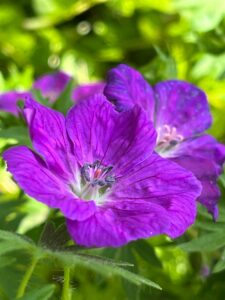
Calendar
BUFFALO REGULAR CLUB MEETINGS African Violet & Gesneriad Society of WNY meets the third Tuesday of the month, September–August, at 7 p.m., Greenfield Health & Rehab

BUFFALO REGULAR CLUB MEETINGS African Violet & Gesneriad Society of WNY meets the third Tuesday of the month, September–August, at 7 p.m., Greenfield Health & Rehab
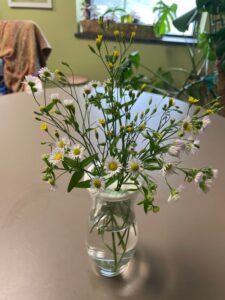
Flower frogs are a helpful tool to assist with arranging flowers because they keep the stems in place. They date back to fourteenth century Japan,
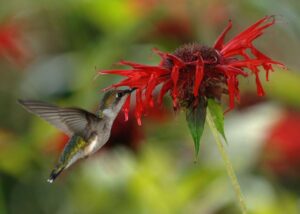
Hummingbirds are incredible little birds with amazing adaptations. During flight they beat their wings anywhere between seventy and 200 times per second, which gives off
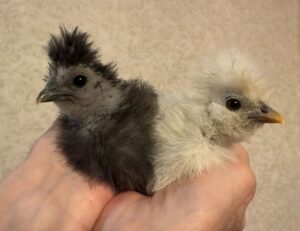
In Dr. Sandra Boysen Sluberski’s backyard, the cluck of chickens mixes with the hum of daily life, a rhythm that reflects her own harmony between

Life is busy, and one great way to simplify mealtime is to prep the day before. Overnight oats have been on-trend for a while now,

On my travels throughout the years, I’ve noticed an unusual shade plant with large spotted leaves. My first encounter was in Ireland when I visited
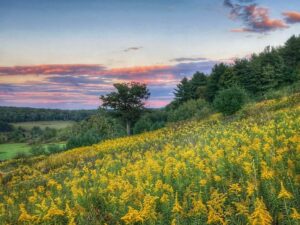
The foliage is growing old; All through the verdure gleams the gold; The rose is turning into mold; But golden rod stands ev’rywhere. Excerpt from
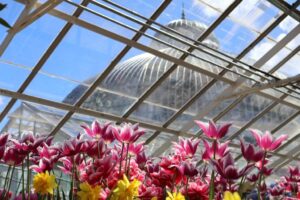
SAP TAP FARMS INTRODUCES SUSTAINABLE WOOL PELLETS Sap Tap Farms is partnering with local sheep farmers to produce a natural, slow-release fertilizer alternative made from

If you’re like me, you are knee-deep in weeds. It seems like one day we’re anxiously watching little sprouts emerge in May and June then

Ahhh summer … Picnics, graduation parties, weddings, backyard gatherings with neighbors. Children at home. ALL. DAY .LONG. I am certain that my children don’t eat
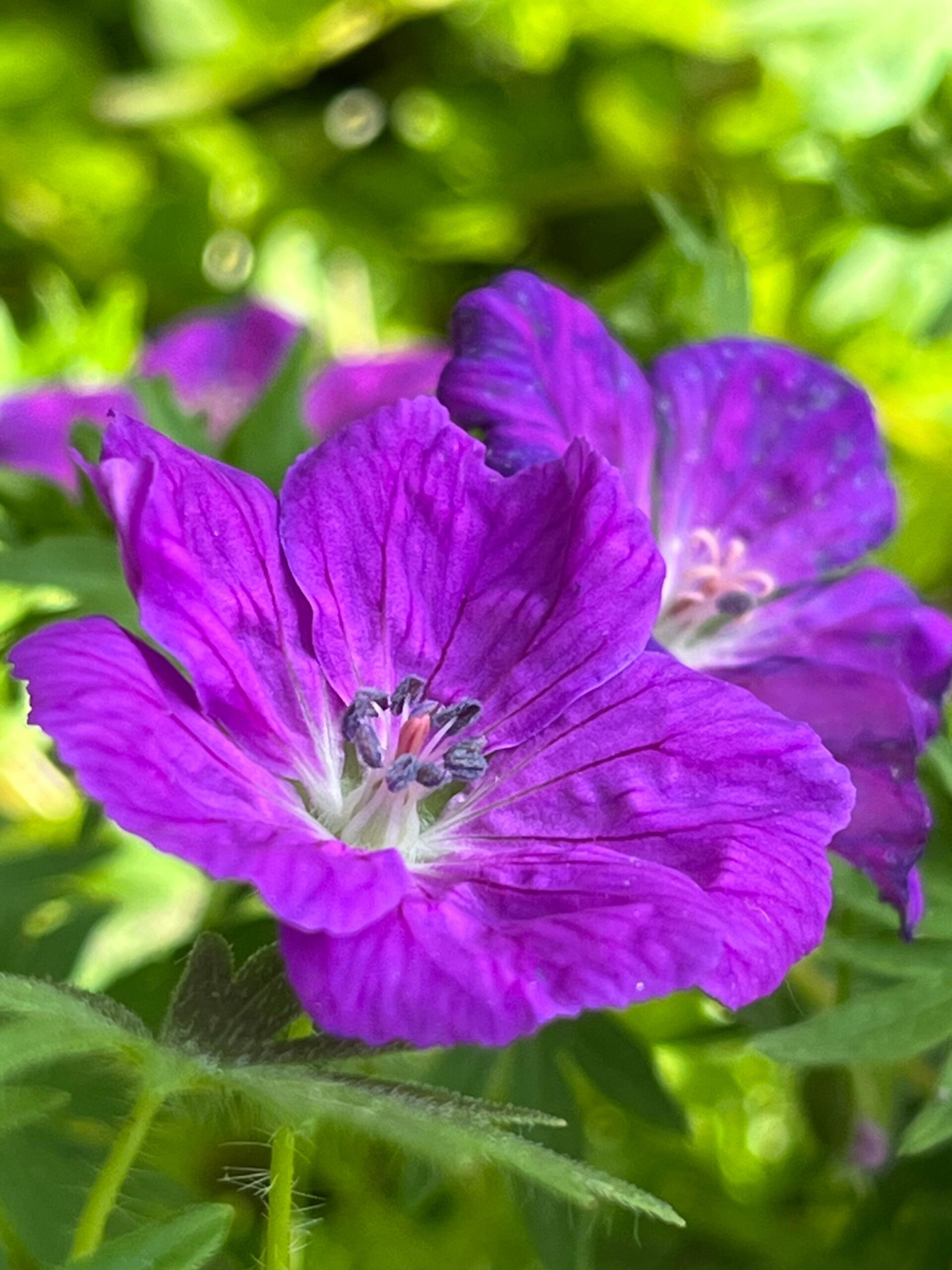
BUFFALO
REGULAR CLUB MEETINGS
African Violet & Gesneriad Society of WNY meets the third Tuesday of the month, September–August, at 7 p.m., Greenfield Health & Rehab Facility, 5949 Broadway, Lancaster. [email protected].
Alden Garden Club meets the second Wednesday of the month (except July and August) at 7 p.m., Alden Community Center, West Main St., Alden. New members and guests welcome. Plant sale each May. 716-937-7924.
Amana Garden Club meets the second Wednesday of the month (except January) at Ebenezer United Church of Christ, 630 Main St., West Seneca. Visitors welcome. 716-844-8543, [email protected].
Amherst Garden Club meets the fourth Wednesday of the month (except December, March, July, and August) at 10 a.m., St. John’s Lutheran Church, Main St., Williamsville. New members and guests welcome. 716-836-5397.
Bowmansville Garden Club meets the first Monday of the month (except June, July, August, and December) at 7 p.m., Bowmansville Fire Hall, 36 Main St., Bowmansville. New members and guests welcome. For more information, 716-361-8325.
Buffalo Area Daylily Society. East Aurora Senior Center, 101 King St., East Aurora. The society is a friendly group who get together to enjoy daylilies. Plant Sales in August. Open gardens, June–August. Facebook.
Buffalo Bonsai Society meets every second Saturday at 1 p.m. at ECC North Campus, STEM Bldg., 6205 Main St., Williamsville, NY 14221. Picnic/Auction; 9/14, (Rochester, NY) Penjing Bonsai; 10/12, Mark Arpag; 11/9, Suiseki with Sean Smith. buffalobonsaisociety.com.
East Aurora Garden Club meets at noon on the second Monday of each month, except January. The clubs meets at Nativity Lutheran Church, 970 E. Main St., East Aurora, NY (just west of the 400 Expressway exit). The club’s objective is to stimulate, create interest, and promote education on horticulture, the art of gardening, flower arranging, and environmental conservation; and to promote the beautification of surrounding areas. For more information about the club or membership call 716- 912-1589.
Federated Garden Clubs NYS–District 8. Nancy Kalieta is the director; [email protected]. gardenclubsofwny.com.
Forest Stream Garden Club meets the third Thursday of the month (September–May) at 7 p.m., Presbyterian Village, 214 Village Park Dr., Williamsville and other locations. Summer garden teas and tours available. Ongoing projects include beautification of the Williamsville Meeting House, garden therapy at a local nursing home, youth gardening, and Victorian Christmas decorating. [email protected].
Friends of Kenan Herb Club meets the third Monday of the month at 2 p.m. at the Taylor Theater. New members are always welcome. kenancenter.org/herb-club.
Garden Club of the Tonawanda meets the third Thursday of the month at 6:30 p.m., Tonawanda City Hall, Community Room. Facebook.
Garden Friends of Clarence meets the second Wednesday of the month at 7 p.m., September– June, Town Park Clubhouse, 10405 Main St., Clarence. [email protected].
Gardens Buffalo Niagara open gardens on Thursdays and Fridays in July starts Thursday, July 11. Explore the beauty of gardens spread out in Erie and Niagara counties. Visit gardensbuffaloniagara.com/ open-gardens-buffalo for more details and location information.
Hamburg Garden Club meets the second Wednesday of each month (except July and August) at 10 a.m. at the VFW Post 1419, 2985 Lakeview Rd, Hamburg, NY. Events include a June plant sale and July and August field trips. New members and guests are welcome. Contact [email protected].
Kenmore Garden Club meets the second Tuesday of the month (except July, August, and December) at 10 a.m., Kenmore United Methodist Church, 32 Landers Rd., Kenmore. Activities include guest speakers, floral designs, and community service. New members and guests are welcome. [email protected].
Ken-Sheriton Garden Club meets the second Tuesday of the month (except January) at 7 p.m., St. Mark’s Lutheran Church, 576 Delaware Rd. Kenmore. Monthly programs, artistic design, and horticulture displays. New members and guests welcome. 716- 833-8799, [email protected].
Lancaster Garden Club meets the second Wednesday of the month (except January, July, and August) at 7 p.m., St. John Lutheran Church, 55 Pleasant Ave., Lancaster. All are welcome. Facebook.
Lewiston Garden Club meets the fourth Monday of the month. See website for meeting information, lewistongardenfest.com/garden-club.html or contact at PO Box 32, Lewiston, NY 14092.
Niagara Frontier Botanical Society meets the second Tuesday of the month September through May at 7:30 p.m. (except April) at the Harlem Rd. Community Center, 4255 Harlem Rd., Amherst. Entrance is on the north side of the building. Meetings are open to the public.
Niagara Frontier Orchid Society (NFOS) meets the first Tuesday following the first Sunday (dates sometimes vary due to holidays, etc.), September– June, Botanical Gardens, 2655 South Park Ave., Buffalo. niagarafrontierorchids.org.
Orchard Park Garden Club meets the first Thursday of the month (except July and December) at 11:30 a.m. at St. John’s Lutheran Church, 4536 South Buffalo St., Orchard Park. Contact Diana Szczepanski at 716- 674-8970 for membership information. Guests are always welcome.
Ransomville Garden Club meets the third Wednesday or Saturday of the month at 5:45 p.m., Ransomville Community Library, 3733 Ransomville Rd., Ransomville. Meetings are open to all. Activities include community gardening projects, educational presentations, and June plant sale. bbonnie2313@ gmail.com.
Silver Creek-Hanover Garden Club meets the second Saturday of the month at 11 a.m., Silver Creek Senior Center, 1823 Lake Rd. (Rte. 5), Silver Creek. [email protected]
South Towns Gardeners meets the second Friday of the month (except January) at 9:30 a.m., West Seneca Senior Center. New members welcome.
Springville Concord Garden Club meets the second Monday of the month at 1:30 p.m. at the Concord Senior Center, 40 Commerce Dr., Springville, NY 14141. Meetings feature guest speakers on a variety of gardening and related topics. Annual July Garden Walk. Guests are welcome.
Town and Country Garden Club of LeRoy meets the second Wednesday of the month (except February) at 6:30 p.m., First Presbyterian Church, 7 Clay St., LeRoy 14482. Prospective members and guests are welcome. Contact: [email protected]. Facebook: facebook.com/GardenClubLeRoyNY.
Town and Country Garden Club of Williamsville generally meets the second Thursday of the month from 2–4 p.m. at the Ransom Oaks Community Club House, 101 Ransom Oaks Dr., East Amherst. Some meetings are held off site for garden tours and special events. The club maintains a garden at the Clearfield Library, 770 Hopkins Rd. Membership brochures with program information are available in the library. For information, contact [email protected].
Tropical Fish Society of Erie County meets the third Tuesday of the month at 7:30 p.m., Lake Erie Italian Club, 3200 South Park Ave., Lackawanna, NY 14218. tropical-fish-club-of-erie-county.com
Western New York Herb Study Group meets the second Wednesday of the month at 7 p.m., Buffalo and Erie County Botanical Gardens, 2655 South Park Ave., Buffalo. Facebook.
Western New York Honey Producers, Inc. Cornell Cooperative Extension of Erie County, 21 South Grove St., East Aurora. wnyhpa.org.
Western New York Hosta Society. The WNYHS was formed to encourage members to appreciate hostas and to provide them with access to quality new varieties. The group meets three times a year at the East Aurora Senior Center, 101 King St., East Aurora NY 14052. wnyhosta.com.
Western New York Hosta Society Breakfast Meetings are friendly get-togethers the first Saturday (winter months only) at 10 a.m., Forestview Restaurant, Depew, wnyhosta.com.
Western New York Iris Society meets at the Julia B Reinstein Library, 1030 Losson Rd., Cheektowaga, NY at 1:30 p.m. on the first Sunday of each month.
Western New York Rose Society meets the third Wednesday of each month at 7 p.m. St. Stephens-Bethlehem United Church of Christ, 750 Wehrle Dr., Williamsville. Check the Facebook page or website for meeting content, wnyrosesociety.net.
Youngstown Garden Club meets the second Wednesday of every month at 7 p.m., First Presbyterian Church, 100 Church St., Youngstown. Facebook.
CLASSES / EVENTS
FREQUENT HOSTS
BECBG: Buffalo & Erie County Botanical Gardens, 2655 South Park Ave., Buffalo, NY 14218. 716/827-1584; buffalogardens.com.
REIN: Reinstein Woods Nature Preserve, 93 Honorine Drive, Depew, NY 14043. 716-683- 5959; reinsteinwoods.org.
F- Indicates activities especially appropriate for children and families.
F June 7- August 3: Butterfly Experience, 10:00 a.m.–4:00 p.m. Flutter down to the Buffalo and Erie County Botanical Gardens and immerse yourself in the winged world of butterflies right here in Buffalo! Step into our brand-new Tropical Orchard, which will be home to hundreds of live butterflies from June 7 to August 3. For the first time ever, visitors will have the chance to get up close and personal with a kaleidoscope of butterflies for an unforgettable experience that you won't find anywhere else in Western New York. Get tickets here buffalogardens.com/events/butterfly-experience BECBG
July 5: Woods Walk: Nature Guide's Choice, 11:00 a.m. This is a guided nature walk through the woods. No registration required. REIN
F July 5, 8, 15: Firefly Walk, 8:30 p.m., Experience the bioluminescent world of fireflies on this guided walk. Registration required; call 716-683-5959. REIN
July 9: Senior Stroll, 10:00 a.m. Experience nature at your own pace and enjoy a leisurely hour-long guided walk through the woods. For adults only. Registration required; call 716-683-5959. REIN
F July 10: Fireflies Under the Full Moon, 8:30 p.m. Experience the bioluminescent world of fireflies on this guided walk – under a full moon! Registration required; call 716-683-5959. REIN
July 12: Friends of Reinstein Woods Artisan Market, 11:00 a.m. – 4:00 p.m. This is a summer Saturday of shopping and sauntering along the trails at Reinstein Woods! There will be fifty different artisans selling handmade soaps, candles, jewelry, fine woodwork, honey, and other handcrafted items. Admission is free (a $2 donation to Friends of Reinstein Woods is appreciated). Rain or shine event. REIN
July 12: Draves Arboretum annual open house tour, 1:30 p.m. This event is an opportunity for the public to learn more about Draves Arboretum and experience the woody species collections through a guided tour of the grounds. Please arrive fifteen minutes prior to start time. Portions of this event will require walking on lawn areas encountering elevation changes. Register at dravesarboretum.org.
F July 12: Sixth Annual Butterfly Release, 8 a.m. – 1 p.m. Gardens Buffalo hosts conservation groups with butterfly release by Eastern Monarch Butterfly Farm. BECBG
S July 12–13: Hamburg Garden Club Sale, 10 a.m. – 4 p.m. The Hamburg Garden Club will have a tent selling garden items. Memorial Park, Union & Lake St., Hamburg, NY.
T July 18–19: Ken-Ton Garden Tour Night Lights, 8:30 – 11 p.m. The Ken-Ton Garden Tour is one of the most anticipated events of the summer in the Ken-Ton community, an annual celebration of color that showcases the hard work and dedication of local gardeners. For more information, visit kentongardentour.com.
F July 19: Woods Walk: Clouds and Flower and Critters, Oh My! 1:00 p.m. Who doesn't love the month of July? Flowers are starting to peak, birds are raising their young, and interesting insects are everywhere. No registration required. REIN
F July 19: Trivia Night, 5:00 p.m. Join us for a fun game of trivia based on nature and Reinstein Woods! Test your knowledge or learn something new. You can sign up solo or as a team. For ages 12 and older. Registration required; call 716-683-5959. REIN
T July 19–20: Ken-Ton Garden Day Tour, 10 a.m.–4 p.m. See description above. kentongardentour.com
T July 19–20: Eastside Garden Walk, 10 a.m.–4 p.m. Free and self-guided tours. Maps are available at the Juneteenth parade, downtown Buffalo public libraries, and online at eastsidegardenwalk.com.
July 26: Summertime Welcome Walk. 10:00 a.m. Learn about the preserve's history and talk about what Reinstein Woods' plants and animals are up to during summer. No registration required. REIN
F July 26: Woods Walk For Kids. 1:00 p.m. What better place to bring kids than Reinstein Woods? Take a walk where kids get to ask the questions. No registration required. REIN
T July 26–27: Garden Walk Buffalo, 10 a.m.–4 p.m. There will be more than 300 gardens on the annual tour. The tour is free and self-guided. Visit Gardenwalkbuffalo.com for more info.
July 27: Friends Member Walk, 9:30 a.m. Stroll through the beauty of nature and enjoy time with other Friends members. Registration required; call 716-683-5959. REIN
F July 30: Going Batty! 8:00 p.m. Bats are amazing animals but are often misunderstood. Separate fact from fiction and learn about the only true flying mammals. Registration required; call 716-683-5959. REIN
F August 2: Woods Walk: The Beginning, 1:00 p.m. Some birds begin migrating in August – shorebirds, swallows, and even songbirds. What else is beginning to change – trees, flowers, day length? Look for the subtle changes in the wonderful landscape of Reinstein Woods. No registration required. REIN
August 5–7: Summer Teacher Institute: Summer Ecology School, 9:00 a.m.–3:30 p.m. Expand your knowledge of Western New York's natural world with three days of hands-on field studies in ponds, forests, and fields. This workshop will feature local research and project highlights from environmental professionals, provide techniques for incorporating nature into your classroom curricula, and strengthen your confidence in using the outdoors as a teaching space. Visit reinsteinwoods.org/explore/programs-services/educator-workshops to register.
F August 9: Wetland Band, 10:00 a.m. Search for frogs, turtles, and birds and recreate the sounds of the swamp. For children ages 3-12. Registration required; call 716-683-5959. REIN
August 13: Senior Stroll, 10:00 a.m. Experience nature at your own pace and enjoy a leisurely hour-long guided walk through the woods. For adults only. Registration required; call 716-683-5959. REIN
F August 16: Stories in the Woods, 10:30 a.m. Enjoy hearing a nature story, followed by a guided walk in the woods. For children ages 3-7. Registration required; 716-683-5959. REIN
F August 16: Woods Walk: Nature Guide's Choice, 11:00 a.m. This is a guided nature walk through the woods. No registration required. REIN
F August 16: Urban Farm Day, 10 a.m.–3 p.m. Experience hands-on learning and come together as a community. Bake pizzas with fresh garden produce, watch worms compost, and listen to talks on brewing your own beer, soil science, and more. The tour is free and self-guided. gardensbuffloniagra.com/urban-farm-day-tour
August 23: Summertime Welcome Walk, 10:00 a.m. Learn about the preserve's history and talk about what Reinstein Woods' plants and animals are up to during late summer. No registration required. REIN
F August 30: Fabulous Fungi, 11:00 a.m. Walkers will join a mushroom enthusiast on this beginner-friendly walk as they attempt to identify as many mushrooms as possible. For ages twelve and older. Registration required; call 716-683-5959. REIN
ITHACA
REGULAR CLUB MEETINGS
Adirondack Chapter, North American Rock Garden Society (ACNARGS) Meetings are open to all. Check the current newsletter on the website for meeting location: acnargs.org or Facebook.com/acnargs.
Auraca Herbarists, an herb study group, usually meets the second Tuesday of the month at noon, Cornell Botanic Gardens, Ithaca. Brown bag lunch at noon followed by the program. and herb of the month. Field trips during the growing season. All are welcome. Contact: Pat Curran, [email protected].
Elmira Garden Club meets the first Thursday of the month, April–December, at 6 p.m., 426 Fulton St., Elmira. Annual plant sale, workshops, monthly meetings, local garden tours and community gardening services. Karen Coletta, 607-731-8320, Facebook.
Finger Lakes Native Plant Society meetings are usually on the third Tuesday of the month September to May. They are an organization dedicated to promoting the appreciation of native flora and hold free public field trips, free indoor programs, and provide members a newsletter, seed exchange, native plant sale, and a December celebration of native plants. flnps.org, [email protected].
Windsor NY Garden Group meets the second and fourth Tuesdays of the month at 10 a.m., members’ homes or Windsor Community House, 107 Main St., Windsor. windsorgardengroup.suerambo.com.
CLASSES/EVENTS
O July 8: Project Ground Nesting Bees, 5:30–6:30 p.m. How can you help to preserve our most threatened and valuable pollinators: the ground-nesting, solitary bees. This online class from Cornell Cooperative Extension, is free, but registration is required. ccetompkins.wufoo.com/forms/zg09npm1gq9p78/
July 26: Ecological Landscape Design Lecture and Tour, 3:00–5:00 p.m. Matt Dallos, owner of Thicket Workshop, will speak about the practices and ideas that support ecological landscape design. While both local and regional projects will be discussed, the primary case study will be a meadow-type planting installed in 2021 on Cornell's Libe Slope. Attendees may join the lecture remotely, but only in-person attendees will get the Libe Slope tour. ccetompkins.wufoo.com/forms/xmhppmx1yhnzhd/
ROCHESTER
REGULAR CLUB MEETINGS
7th District Federated Garden Clubs New York State, Inc. meets the first Wednesday of the month. 7thdistrictfgcnys.org.
African Violet and Gesneriad Society of Rochester meets the first Thursday of the month September– November and March–May, 7–9 p.m. at Messiah Lutheran Church, 4301 Mt. Read Blvd., Rochester, NY 14616. December and June meetings are social events TBD location. Contacts: Douglas Burdick, 585-313-8674, [email protected]. Barb Festenstein, 585-461-1673, [email protected].
Bloomfield Garden Club meets the third Thursday of the month at 11:45 a.m., Veterans Park, 6910 Routes 5 & 20, Bloomfield. Visitors and prospective new members welcome. Marlene Moran, 585-924-8035, Facebook.
Bonsai Society of Upstate New York meets the fourth Tuesday of the month at the Brighton Town Park Lodge, Buckland Park, 1341 Westfall Rd., Rochester. 585-334-2595, Facebook, bonsaisocietyofupstateny.org.
Canandaigua Botanical Society meets for in-person botanical events. See website for event schedule. canandaiguabotanicalsociety.blogspot.com
Color Pittsford Green meets on the third Wednesday of the month, 6:45–7:45 p.m. via Zoom. All are welcome. colorpittsfordgreen.org
Conesus Lake Garden Club meets the third Wednesday of the month (April–December) at 7 p.m., Chip Holt Nature Center, Vitale Park, Lakeville. Welcoming new members. Contact Dottie Connelly, 585-703-1748.
Country Gardeners of Webster This club is for those who like to dig in the dirt, smell the roses, learn about the birds and bees, take a walk in the park, eat, drink, and be merry, or live in Webster. They meet the second Monday of the month. Contact Elaine at 585-350-8270 to try this fun-loving club out.
Creative Gardeners of Penfield meets the second Monday of the month (except July and August) at 9:15 a.m., Penfield United Methodist Church, 1795 Baird Rd., Penfield. Visitors welcome. Contact 585- 385-2065 or [email protected] if interested in attending a meeting.
Fairport Garden Club meets the third Thursday evening of the month (except January, February, March, and August) in members’ homes or in the Perinton Ambulance building. Educational topics are presented through speakers, workshops, local tours, and community gardening i.e., Planter at Johanna Perrin School. [email protected], fairportgardenclub.com.
Finger Lakes Daylily Society members garden in west-central NY, covering an area from Batavia to Syracuse and the Southern Tier. Meetings are held in Rochester or the Canandaigua area. There are generally four regular Saturday meetings held in February, March, May, and September. Visitors and prospective new members are welcome to attend. Contact Deb Lawrence for information, [email protected].
Friends of Ellwanger Garden meet all season long on Tuesday mornings. To volunteer at the garden, please contact Cindy Boyer at 585-546-7029, x12 or [email protected].
Garden Club of Brockport meets the second Wednesday of every month at 7 p.m., Jubilee Church, 3565 Lake Rd., Brockport. Visitors can learn gardening tips from knowledgeable speakers, make garden ornaments through hands-on classes, and explore beautiful local gardens. For more info please email [email protected].
Garden Club of Mendon meets the third Tuesday of the month, 10 a.m.–1 p.m., Mendon Community Center, 167 North Main St., Honeoye Falls. Members work on community gardens and gather new ideas in a casual, social environment. 585-624-8182, [email protected].
Garden Path of Penfield meets the third Wednesday of the month, September–May at 7 p.m., Penfield Community Center, 1985 Baird Rd., Penfield. Members enjoy all aspects of gardening, new members welcome. [email protected].
Gates Garden Club meets the second Thursday of the month (except July and August) at 6:30 p.m., Gates Town Annex, 1605 Buffalo Rd., Rochester. New members and guests welcome. 585-247-1248, [email protected].
Genesee Region Orchid Society (GROS) meets the first Monday following the first Sunday of the month. Meetings are held at 6 p.m. at the JCC on Edgewood Dr in Brighton. Please see the website for information, geneseeorchid.org.
Genesee Valley Hosta Society meets the second Thursday of the month, April–October, at Eli Fagan American Legion Post, 260 Middle Rd., Henrietta. 585-889-7678, [email protected], geneseevalleyhosta.com.
Greater Rochester Iris Society (GRIS) is an affiliate of the American Iris Society, meets on a Sunday during the months of March, April, September, and October at 2 p.m., St. John’s Episcopal Church Hall, 11 Episcopal Ave., Honeoye Falls, NY. Public welcome. Plant Sales, guest speakers or location visits, Volunteer Opportunities. Honeoye Falls, NY. 585-266-0302, [email protected].
Greater Rochester Perennial Society (GRPS) meets the first Thursday of each month at 7 p.m., Twelve Corners Presbyterian Church Fellowship Hall, 1200 South Winton Rd., Rochester, except in summer when it tours members’ gardens. Lectures are held virtually, and garden tours are being scheduled. See website or Facebook for updates. cap704@ frontiernet.net, rochesterperennial.com, facebook.com/GreaterRochesterPerennialSociety.
Greater Rochester Rose Society meets the first Tuesday of the month at 7 p.m. on Zoom January, February, and March Email [email protected] for meeting link. Questions: 585-694-8430. Facebook: Greater Rochester Rose Society.
Henrietta Garden Club meets the second Wednesday each month (except May-August and December) at 6:30 p.m. A presenter will speak on a gardening related subject at 7:15 p.m. Guests and nonresidents are welcome. Handicap accessible. Call 585-442-8634. Lower level of the Henrietta Town Hall, 475 Calkins Rd., Henrietta. sites.google.com/site/henriettagardenclub. Facebook page. [email protected].
Hilton Garden Club meets the second Wednesday of the month, except May-August and December at 6:30 p.m. at The Henrietta Town Hall, Lower Level, 475 Calkins Rd., Henrietta. Handicap accessible. Guests and nonresidents are welcome. Call 585-442-8634 or visit sites.google.com/site/henriettagardenclub.
Holley Garden Club meets the second Thursday of the month at 7 p.m., Holley Presbyterian Church. 585- 638-6973.
Hubbard Springs Garden Club of Chili meets the third Monday of the month at 6:30 p.m. at the Chili Community Center, 3237 Chili Ave., Rochester. [email protected]
Ikebana International Rochester Chapter 53 meets on zoom February to April at 10 a.m. the third Thursday of each month. Beginning in April, meetings are in-person. There are no meetings in December and January. Attendees will participate in an ikebana workshop, enjoy fellowship with your own brown-bag lunch, and have a short culture program following lunch. Ikebana International is a non-profit cultural organization whose objective is to stimulate and perpetuate the study of ikebana (the Japanese art of flower arranging) and related arts throughout the world. In-person meetings are at First Baptist Church, Hubbell Hall, 175 Allens Creek Rd., Rochester. rochesterikebana@ gmail.com, ikebanarochester.org. Visitors can view the chapter’s ikebana exhibit at the Greater Rochester Orchid Society show March 27–30, Fri. 1–4 p.m., Sat. 10 a.m.–5 p.m, Sun 10 a.m–4p.m. Rochester Museum and Science Center’s Eisenhart Auditorium, 657 East Ave., Rochester.
Kendall Garden Club meets the first Wednesday of the month at 7 p.m., Kendall Town Hall. 585-370-8964.
Klemwood Garden Club of Webster meets the second Monday of the month at 7 p.m. (except January and February) in members’ homes or local libraries. Accepting new members. 585-671-1961.
Lakeview Garden Club (Greece) meets the second Wednesday of the month (except January and February) at 7 p.m., meeting location varies depending on activity. Meetings may include a speaker, project or visits to local garden-related sites. New members always welcome. Contact, Darlene Markham, [email protected].
Newark Garden Club meets the first Friday of the month at 1 p.m., Park Presbyterian Church, Newark. Guests are welcome.
Pittsford Garden Club Pittsford Garden Club meets the third Tuesday of the month at 10:30 a.m. at the Spiegel Center on Lincoln Ave. in the Village of Pittsford. The club usually meets in Room 18, but visitors should confirm at the front desk. New members are always welcomed. Annual plant sale on the third Saturday in May, parking lot behind the library. [email protected]
Rochester Dahlia Society meets the second Saturday of the month (except August and September) at 12:30 p.m., Trinity Reformed Church, 909 Landing Rd. North, Rochester. Visitors welcome. See website for up-to-date information concerning meetings and shows. 585-865-2291, Facebook, rochesterdahlias.org.
Rochester Herb Society meets the first Tuesday of each month (excluding January, February, and July) at noon, Pittsford Community Center, 35 Lincoln Ave., Pittsford, NY. Summer garden tours and day trips. New members welcome. rocherbsociety.com.
Rochester Permaculture Center meets monthly to discuss topics such as edible landscapes, gardening, farming, renewable energy, green building, rainwater harvesting, composting, local food, forest gardening, herbalism, green living, etc. Meeting location and details: meetup.com/rochesterpermaculture.
Seabreeze Bloomers Garden Club meets the fourth Wednesday of the month (except January) at 7 p.m., location varies depending on activity. Meetings may include a speaker, project, or visit to local gardenrelated site. Monthly newsletter. New members welcome. Meetings are currently canceled, contact Bonnie Arnold with any questions. Bonnie Arnold, 585-230-5356, [email protected].
Stafford Garden Club meets the third Wednesday of the month (except December and January) at 7 p.m., Stafford Town Hall, 8903 Morganville Rd. (Route 237), Stafford. All are welcome. 585-343-4494.
Urban Agriculture Working Group (UAWG) meets via Zoom on the third Thursday of the month at 7 p.m. UAWG is a collection of gardeners, community gardens, and individuals who garden/farm in the city or support such activities. UAWG offers a Spring Conference each year and sponsors the Urban Gardens ROC garden crawl in the fall. In addition, the group advocates for City policies that make urban gardening more accessible for people who want to grow fresh vegetables for themselves or their neighbors. If you are interested in getting on the email list, contact Mallory Hohl, [email protected]. You do not have to live in the city to participate.
Victor Garden Club meets the second Wednesday of the month (except January and February) at 6 p.m. New members welcome. Meeting and location details: victorgardenclubny2.com, victorgardenclub.org.
The Webster Arboretum. 1700 Schlegel Road, Webster. thewebsterarboretum.org.
Williamson Garden Club. On-going community projects and free monthly lectures to educate the community about gardening. Open to all. 315-524-4204, [email protected], growthewilliamsongardenclub.blogspot.com.
FREQUENT HOSTS
BFF: B-friendly Farm and Garden, 2755 Penfield Road, Fairport 14450. 585-424-4476; broccolotreeandlawn.com
CCE/GC: Cornell Cooperative Extension, Genesee County, 420 East Main St., Batavia, NY 14020. 585-343-3040, ext. 132; genesee.cce.cornell.edu.
CLASSES / EVENTS
S- Indicates plant sales/swaps.
T- Indicates garden tours.
O- Online event.
F July 3–August 7: The Broccolo Bug Club at the B-Friendly Farm, 10 a.m. This series of events are an interactive way for school-age kids to engage and explore nature play. Children will catch and release bugs safely. This is for ages between 7 and 12, younger kids must be accompanied by an adult. Cost is $15 a session and $12 for siblings. BFF
July 8: Lunchtime Talk: Noon. Laura Ouimette will share a lunchtime talk about the 150 year history of the Canandaigua Botanical Society at the Ontario County Historical Society, 55 North Main Street, Canandaigua.
July 10–31: Nature, History, & Community Through Art, Railroad Street Artworks, This is a new art exhibit showcasing and celebrating Monroe County’s Parks through fine art. Visitors can expect to see an array of two-dimensional (2-D) works in all mediums including painting, photography, and drawing. 3 Railroad St., Suite G Fairport.
July 11: Orleans Produce Auction, Tuesdays and Fridays at 10 a.m. between April 25 and July 11. Also Mondays 11 a.m., Wednesdays 10 a.m., and Fridays 10 a.m. between July 14 and September 19. The auctions will feature a variety of flowers and locally grown fruits and vegetables. The Orleans Produce Auction is located at 12590 Ridge Rd., Albion, NY 14411. For more information, contact auctioneer Caleb Nicodemus at 585-322-6331.
July 12, 18, 19, 27: Daylily Garden Open House, 2:00– 6:00 p.m except July 19, 4:00–7:00 p.m. Cobbs Hill Daylily Garden (a National Daylily Display Garden), Charlie and Judy Zettek, 1 Hillside Avenue, Rochester 14610. You may view the garden from the road, or you may walk through the garden during our open house times. Please call 585-461-3317 ahead of time if you have any questions.
F July 15: Butterfly Walk of White Haven Park, 10 a.m. Explore the grounds of White Haven Park looking for Monarchs and other butterflies that call the park home. White Haven Memorial Park, 210 Marsh Road, Pittsford, NY 14534. thebirdhouseny.com
F July 16: Creative Critters Rock Painting, 10:30 a.m.– noon. B-Friendly Farm and Gardens introduces the Creative Critters Rock program with themes such as ladybugs, snakes, or in the natural world. Cost is $15 per child. BFF
July 17: Fruit Jelly Canning. 6:00–8 p.m. This is a handson, small-group workshops designed to teach the basics of water bath canning—Start with fresh fruit juice and learn to craft beautifully clear jellies—plus sample some fun flavor twists! All classes are held at Stafford Methodist Church. Register online at genesee.cce.cornell.edu/events CCE/GC
F July 19: The Frog Lady: Margot Fass MD “Honoring Life—One Frog at a Time,” 10 a.m. This presentation will take place outdoors (rain or shine) on the far side of the pond and is catered to children 6–9 years old. Check out her whimsical illustrated children’s book, Froggy Family’s First Frolic and discover the life of the frog. This presentation will take place outside rain or shine. 1700 Schlegel Rd, Webster.
T July 19: The Seymour Library Foundation Annual Garden Tour: Stunning Gardens by Ordinary People, 11 a.m.–4 p.m. Rain date: Sunday, July 20. Reservations will remain at $25 per person. Please contact the Seymour Library Foundation for sponsor opportunities. [email protected]
F July 19–26: 4-H Program Project show, Stop by the Genesee County Fair to see the 4-H Program’s projects that will be shown the whole week related to agriculture. gcf.org
T July 19: Visit to Native Shorescaping at Walton Point, 10:00 a.m. There will be a tour of Lucy and Phil Sheils’ property in Woodville, NY. They have transformed their shoreline property into a thriving, beautiful, lake-friendly oasis on the shores of Walton Point. canandaiguabotanicalsociety.blogspot.com
July 24: Owl Prowl at White Haven Park. 8–9:30 p.m. Guests will listen and search for Screech, Barred, and Great Horned Owls. White Haven Memorial Park, 210 Marsh Road, Pittsford, NY 14534. thebirdhouseny.com
T July 26: Kiwanis Club Annual Garden Tour, This tour is showcasing six stunning gardens, along with an exclusive tour of the oldest historic home in Pittsford, dating back to 1793. bushnellsbasinpittsfordkiwanis.org/garden-tour
July 31 & Augusts 28: Telescope Night at White Haven, 7–10 p.m. Interested in the stars? Have you ever found a constellation? The Bird House is hosting a relaxing evening identifying some constellations and their brightest stars in the night sky. thebirdhouseny.com
August 1: Hydrangeas Walk and Talk with George Riehle, 7 p.m. Hydrangea, commonly named the hortensia, is a genus of more than seventy species of flowering plants native to Asia and the Americas. Attendees will learn all about the various species and how to care for this much-loved plant. This presentation will take place outside rain or shine. 1700 Schlegel Rd, Webster.
S August 2: Plant Sale with Michael Hannen. 10 a.m.–4 p.m. at The Bird House, 3035 Monroe Ave., Rochester, NY 14618 thebirdhouseny.com
F August 9: Stick-bugs and Leaf shaped insects B-Friendly Farm and Gardens gets creative making Stick-bugs and Leaf shaped insects. Family fun for adults bringing children. BFF
August 11: Photo Contest Begins. The Bird House Photo Contest: Submissions will be accepted through Sunday, September 21. Customers choice voting is the week of September 22, and winners will be announced on September 30. thebirdhouseny.com
August 16: Monarch Butterfly Class, 10 a.m. Learn all about the biology, characteristics, and migration of the Monarch Butterfly. After the class, weather permitting, students will see if they can find any Monarchs or other butterflies in the garden. White Haven Memorial Park, 210 Marsh Road, Pittsford, NY 14534. Meet at the All Seasons/Gathering Room. thebirdhouseny.com
August 28: Canning Tomatoes, 6:00 p.m.–8:00 p.m. This hands-on class covers all the basics of hot water bath canning, including both hot and cold pack methods. Students will also discuss jams and jellies. Each participant will can a quart of tomatoes (ready for pickup the next day at the CCE office). Register by August 22 and $25 per person. All classes are held at Stafford Methodist Church. Register online at genesee.cce.cornell.edu/events CCE/GC
SAVE THE DATE…
September 9: Dahlias with Patty Pirz, 7 p.m. Discover the culture, type, variety and care of the beloved Dahlia. Learn how to grow and nurture these plants to their best advantage. The presentation will take place in the Curry Building. 1700 Schlegel Rd, Webster.
October 7: Bonsai presentation with Mark Arpag, 7–8 p.m. Mark Arpag is an award-winning International Bonsai Artist living in Rochester, New York. He is a long-time active member & current president of the Bonsai Society of Upstate New York. Arpag will bring examples of bonsai for viewing. The presentation will take place in the Curry Building. 1700 Schlegel Rd., Webster.
F November 8: Bird Seed Ornaments, 9:30 a.m. Families can visit the Arboretum to learn how to make ‘bird cookies.” This event will take place at the Webster Parks and Recreation Center, 1350 Chiyoda Dr. in Room 210.
SYRACUSE
REGULAR CLUB MEETINGS
African Violet and Gesneriad Society of Syracuse meets at 7:00 pm, on the second Thursday of the month, September to December and March to May, there are no meetings in January or February due to weather conditions. The meeting place is Pitcher Hill Community Church, 605 Bailey Road, North Syracuse, NY 13212. More information is available on the chapter website (avsofsyracuse.wixsite.com/avgss) or via email [email protected] or call 315-633-2437
Baldwinsville Women’s Garden Club meets the first Thursday of each month except January at St Marks’ Lutheran Church in Baldwinsville at 7 p.m. The club plants the village flower barrels, raises money for the village flower hanging baskets, maintains the Pointe Garden, donates Arbor Day trees to schools, and gets involved in village improvement projects. Perennial sale yearly on Memorial Saturday morning in the village. See more information at Facebook, Women’s Garden Club of Baldwinsville.
Bonsai Club of CNY (BCCNY) meets the first Saturday of the month 10 a.m.–12 p.m., Pitcher Hill Community Church, 605 Bailey Rd., North Syracuse. Contact Dave Taylor, [email protected] or 315- 395-3018. cnybonsai.com, Bonsai Club of CNY on Facebook.
Cazenovia Garden Club usually meets the first Tuesday of the month at 10:15 a.m. at the Cazenovia Public Library. With an active membership, their objective is to stimulate interest in horticulture, develop skills in the beautification of community and home, and create awareness of national and local conservation issues. Meetings feature guest speakers and field trips are planned throughout the year. For more information contact [email protected].
Central New York Orchid Society meets the first Sunday of the month, September–May, St. Augustine’s Church, 7333 O’Brien Rd., Baldwinsville. Dates may vary due to holidays. 315-633-2437, cnyos.org.
Fairmount Garden Club meets the third Thursday of the month (March–November) at 6:30 p.m., Camillus Senior Center, 25 First St., Camillus. Speakers and community projects. All are welcome. [email protected].
Federated Garden Clubs NYS–District 6. 315-481- 4005, [email protected].
Gardening Friends Club meets the third Tuesday of the month, March–December, at 6:30 p.m., Wesleyan Church, 4591 US Route 11, Pulaski. 315-298- 1276, Facebook: Gardening Friends of Pulaski, NY, [email protected].
Gardeners in Thyme (a women’s herb club) meets the second Thursday of the month at 7 p.m., Beaver Lake Nature Center, Baldwinsville. 315-635-6481, [email protected].
Habitat Gardening in CNY (HGCNY) meets the last Sunday of most months at 2 p.m. Liverpool Public Library, 310 Tulip St., Liverpool. HGCNY is a chapter of Wild Ones: Native Plants, Natural Landscapes; wildones.org. Free and open to the public. hgcny.org and ourhabitatgarden.org. Subscribe to the free e-newsletter by emailing [email protected].
Home Garden Club of Syracuse usually meets the first Tuesday morning of the month. Members are active in educating the community about gardening, horticulture, and floral design and are involved with several civic projects in the Syracuse area. New members welcome. [email protected], homegardenclubofsyracuse.org.
Koi and Water Garden Society of Central New York usually meets the third Monday of each month at 7 p.m. See website for meeting locations. 315-458- 3199, cnykoi.com.
The Men and Women’s Garden Club of Syracuse meets on the third Thursday of each month at 7 p.m. in the Reformed Church of Syracuse, 1228 Teall Ave., Syracuse, NY. Meetings feature activities and/ or guest speakers on gardening-related topics. The club also plans tours for its members. Members maintain gardens at Rosamond Gifford Zoo and Ronald McDonald House plus host annual flower shows. Regular club meetings at the church will take place in the months of March, April, May, August, September, and November. More information at facebook.com/MWGardenClubOfSyracuse and [email protected].
Southern Hills Garden Club meets the third Tuesday of each month, February through November, at the LaFayette Firehouse, 2444 US Route 11, LaFayette NY 13084. Meetings begin at 7:00 pm. Offsite meetings typically have an earlier start time. Guests are welcome and membership is open to anyone interested in gardening. For information regarding meetings or membership, please contact Cathy Nagel, 315-677-9342 or Email [email protected]
Syracuse Rose Society meets the second Thursday of the month (except December) at 7 p.m., Reformed Church of Syracuse, 1228 Teall Ave., Syracuse. Enter from Melrose Ave. Club members maintain the E. M. Mills Memorial Rose Garden, Thornden Park, Syracuse. Public welcome. syracuserosesociety.org.
Seneca County Community Garden Club members meet on the first Wednesday of each month at the Seneca Falls Recreation Center, 35 Water St., Seneca Falls, NY $20 individual/ family plots available. New members always welcome, and you don’t have to be a Seneca Falls resident to join.
CLASSES / EVENTS
July 8–30: Summer Youth Garden Club, 9–11:30 A.M. In this hands-on series, kids will learn from CCE Master Gardeners about soil composition, composting/ vermicomposting, Plant requirements, common plants, and more. CCE/SC
July 13: Fern Walk with Mike Serviss, 2–4 p.m., Join biologist Mike Serviss on a hike as he identifies and speaks on the wide variety of ferns found at Clark Reservation. Mike is a rare and threatened plant conservation specialist with a focus on propagation and reintroduction, and has worked extensively with the endangered Hart’s Tongue Fern. Meet at the Clark Reservation Nature Center, Clark Reservation State Park, 6105 E Seneca Turnpike, Jamesville, NY 13078. Some of the trails can be challenging, so please come prepared! HGCNY
July 16: CCE Oneida County Gardens Open House, 4:00–7:00 p.m. Held at the Extension’s Parker F. Scripture Botanical Gardens, CCE Oneida County, 121 Second Street, Oriskany, NY 13424 (315) 736-3394
July 22: Garden Pickles & Relishes, 6–7:30 p.m. Learn how to make pickles, relishes, and chutneys with local vegetables and fruits that are in season through hands-on demonstrations led by CCE Seneca Master Food Preservers. CCE/SC
July 26: Show Me, Help Me Garden Tour. 4:00–7:00 p.m. This is a guided tour of Wild Ones HGCNY member Jennifer Staples’s property, showcasing a thoughtful approach to native planting and habitat creation. Jennifer has shaped her landscape to support local wildlife while maintaining a friendly, traditional curb appeal. HGCNY
Deadline for calendar listings for the next issue (September-October 2025) is August 11, 2025. Please send your submissions to [email protected].
This article originally appeared in the July/August 2025 issue of Upstate Gardeners’ Journal.
Upstate Gardener's Journal
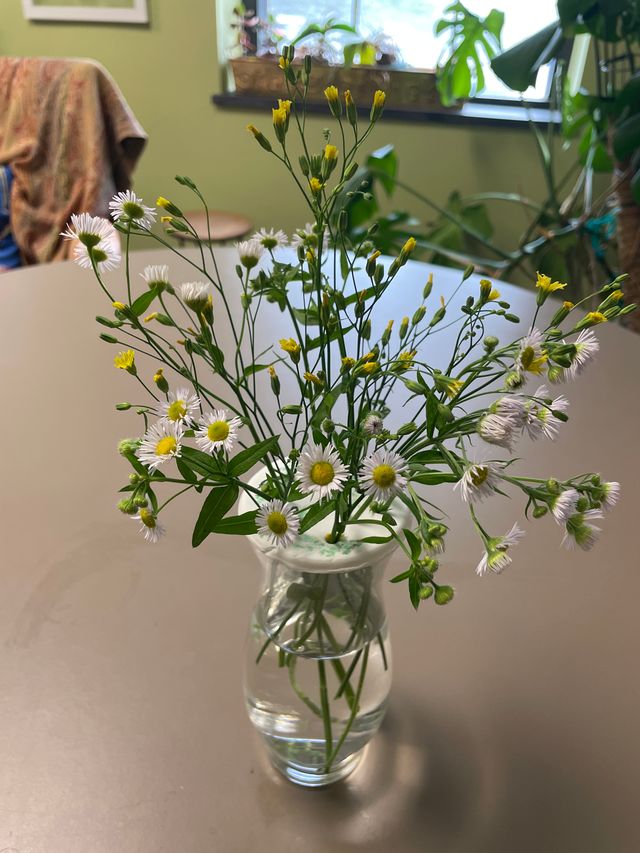

Flower frogs are a helpful tool to assist with arranging flowers because they keep the stems in place. They date back to fourteenth century Japan, became popular here in the early 1900s, then fell out of style when floral foam became the rage in the late 1950s. With the growing problem of microplastics in the environment, taking a step back in time to recycle an old idea is appropriate—and fun.
SUPPLIES/TOOLS
Waxed paper
Air-dry clay
1/4-inch wood dowels
Rolling pin
Round biscuit or cookie cutter slightly larger than vase opening (a vessel like a drinking glass works also)
Doily, leaves from the garden, or clay texture stamps (optional)
Drinking straw
Paint brush
Clay sealant
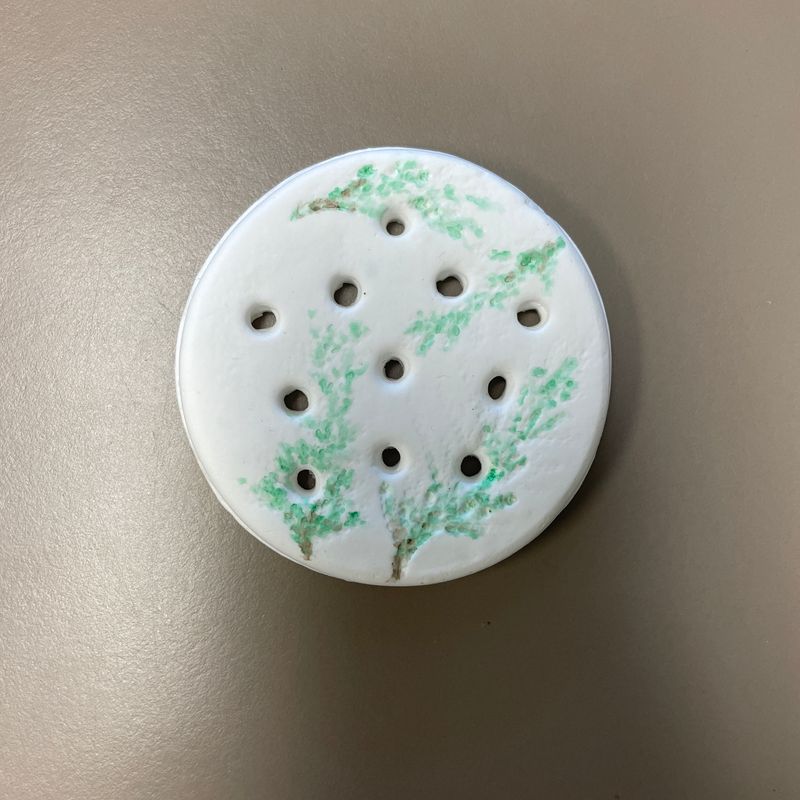
DIRECTIONS
1. Place dowels about five inches apart on wax paper.
2. Roll clay flat with rolling pin, then set dowels aside.
3. If desired, lay doily on clay and gently roll it into the clay just to enough to make an imprint of the texture. Alternatively, press a clay texture stamp or leaves into the clay to achieve desired look. Gently remove doily, leaves, or stamp.
4. Place round cutter on clay, press down, and twist gently to cut out shape. Remove excess clay, then cutter.
5. Use the drinking straw to punch holes in clay at various locations on flower frog.
6. Flip frog over. Use top of vase to press an indentation into clay to create a lip, then remove.
7. Allow clay to fully dry according to product directions. Optional step: Paint frog before sealing. See air-dry clay product instructions for best type of paint and drying times.
8. After fully dry, use paintbrush to add sealant of choice to project. Make sure to completely coat surface to ensure frog is protected from water that may come in contact with it.
9. Fill vase with water and place frog on top of vase. Arrange flowers as desired.
Cathy Monrad is the graphic designer for Upstate Gardeners' Journal.
This article originally appeared in the July/August 2025 issue of Upstate Gardeners’ Journal.
Upstate Gardener's Journal
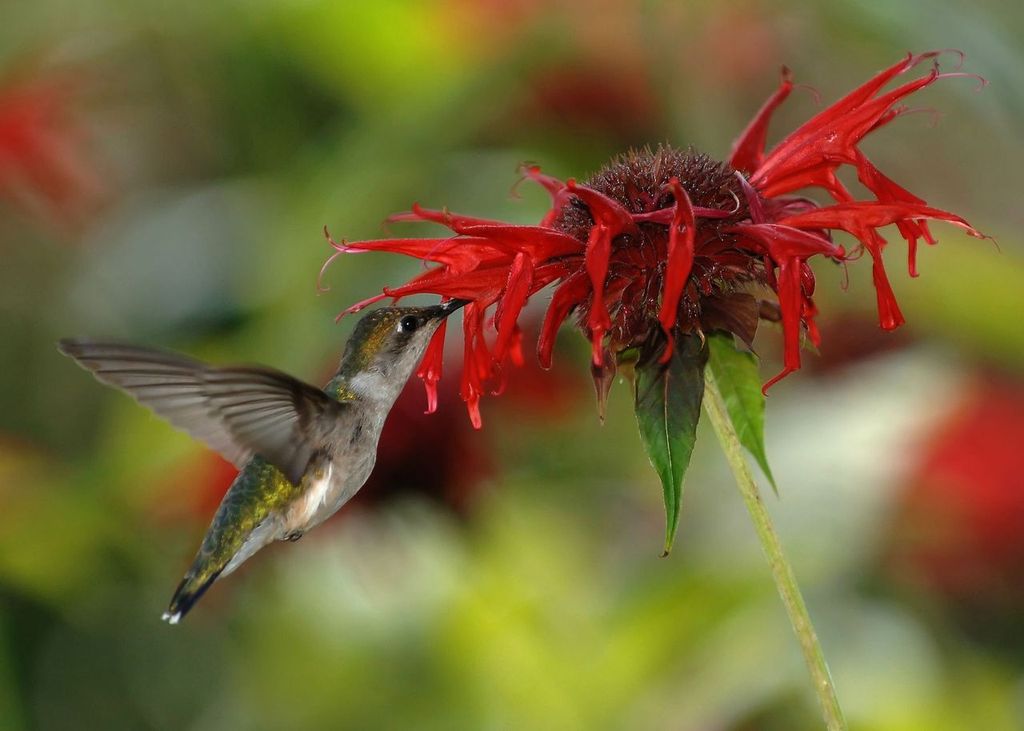

Hummingbirds are incredible little birds with amazing adaptations. During flight they beat their wings anywhere between seventy and 200 times per second, which gives off the humming sound they are named for. They can hover, fly backwards and straight up and down, and are even known to make somersaults in the air. Their long bills are perfect for drinking nectar from deep, tubular flowers, and they also eat insects. All hummingbird species are small, and the smallest bird in the world is the Bee Hummingbird, which is only two inches long.
The Eastern United States is home to one hummingbird species: the Ruby-throated Hummingbird. Ruby-throated Hummingbirds are Neotropical migrants, meaning make take long-distance migrations to their breeding grounds in the spring and summer and then migrate back down to their winter ranges in the fall. Each year these incredible migrators come back to upstate New York around the first week of May and by the end of September are all but gone from our area. This migration from Central America up north, sometimes into Canada, can be more than 2,000 miles long. On this migration some hummingbirds will fly directly over the Gulf of Mexico, which on its own can take up to twenty-four hours. While they are here, hummingbirds can be attracted to backyards with feeders, plants, nesting material, and water.
Hummingbirds can be easy to attract and will eagerly visit hummingbird feeders in the spring when they need a lot of calories to replace those they have burned off from their miles of migration. In the fall we also see an uptick of hummingbirds visiting feeders when they are getting ready to migrate back down south. Hummingbird nectar can be purchased, or you can make your own. The recipe for hummingbird nectar is one part sugar to four parts water. Use white, granulated sugar and mix it with boiling water. There is no need to add any dyes, as it’s not known if the dyes can harm the hummingbirds. Hummingbird nectar can be put in a variety of feeders. Having one that is easy to take apart and clean is key to making sure the nectar is always fresh and healthy for the birds. A feeder that is red in color will help draw in hummingbirds, as they are attracted to the color red. These little birds are territorial and will actively defend food sources! The key to getting more hummingbirds in your yard is to put up multiple feeders that are out of sight of each other.
Hummingbirds also love plants, especially those with long, red, tubular flowers Some enticing native species include the cardinal flower (Lobelia cardinalis), bee balm (Monarda didyma), wild columbine (Aquilegia canadensis), coral honeysuckle (Lonicera sempervirens), trumpet vine (Campsis radicans) and phlox (Phlox maculata.) Other hummingbird favorites that can readily be found in garden centers include: salvia, hyssop, crocosmia, fuchsia, and gladiolus. Although they are now commercially available, hummingbirds will not use any kind of hummingbird “house” you may see on the market. Hummingbirds are not cavity nesters, and they will build their own nest in a tree. Ruby-throated Hummingbirds will build a tiny nest where they usually lay two eggs. They tend to build a nest high up in a deciduous tree, usually between ten and forty feet high, so nests can be hard to see. Often hummingbirds come back to the same area they were born to build a nest. The nest is built from soft, downy plant fibers, spider webs, and lichen. While most of the material hummingbirds use to build their nests come from plants and spider webs, you can provide them with natural cotton to help supplement their nest building. The female will sit on her eggs for about two weeks until they hatch, and once hatched they will be in the nest for about three weeks and then they are ready to go out into the world.
Water is another way to attract hummingbirds. They usually do not splash around in birdbaths like larger birds will, but they do need water to survive. The best way to attract them is with moving water, especially with a fountain or a mister. Misters are nozzles that can be attached to a hose that, when running, will create a fine mist that the hummingbirds can fly through. Fountains can also create this misting feature. Any birdbath can be turned into a fountain feature with a solar fountain insert, which will recirculate the water in the bath. We often hear stories of hummingbirds taking advantage of a sprinkler to fly through its mist in the summer months.
Hummingbirds are called flying jewels, and for good reason. The emerald-green coloration of the Ruby-throated Hummingbird lights up the garden when the sun hits their plumage in a spectacular way. The males have ruby-colored throats, which also give the garden a beautiful pop of color. These birds will be here all summer long, and there are many different ways to attract them that it is easy to invite even just one to the garden.
Liz Magnanti is co-owner of the Bird House in Brighton, NY.
This article originally appeared in the July/August 2025 issue of Upstate Gardeners’ Journal.
Upstate Gardener's Journal
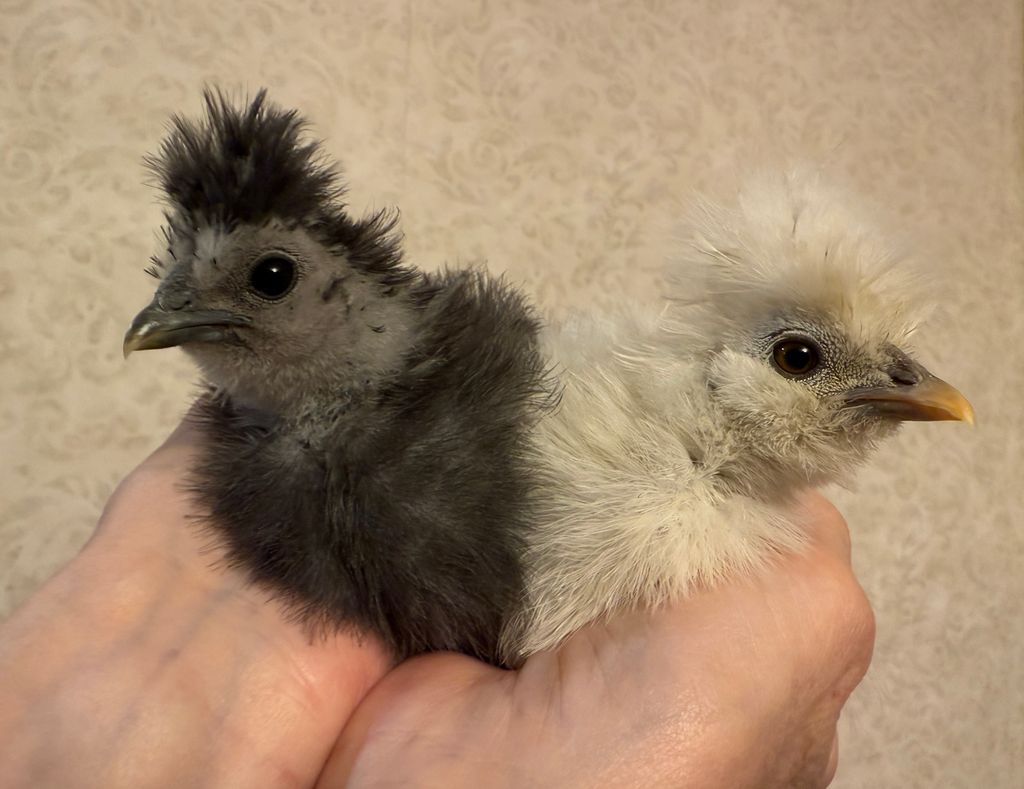

In Dr. Sandra Boysen Sluberski’s backyard, the cluck of chickens mixes with the hum of daily life, a rhythm that reflects her own harmony between music, mindfulness, and her hens. Boysen Sluberski’s chickens have become much more than farm animals; they are storytime stars and companions, delighting children and adults all around the Rochester area.
After moving from Florida to Rochester in 2007, Boysen Sluberski bought two Rhode Island Red hens, meaning to keep them as pets and for eggs. After getting involved with the Rochester City Chicken Club, she was asked to open her backyard for “Citywide Urban Coops Day,” where other chicken owners and the public could tour people’s backyards and their coops.
“People were really surprised you could even keep chickens in the city,” Boysen Sluberski says. “That was the time I first realized people want to know about these things.”
A year after that event, Boysen Sluberski brought her chickens out for the first time, to the Rundell Library in Rochester, for an event called “Life Hack.”
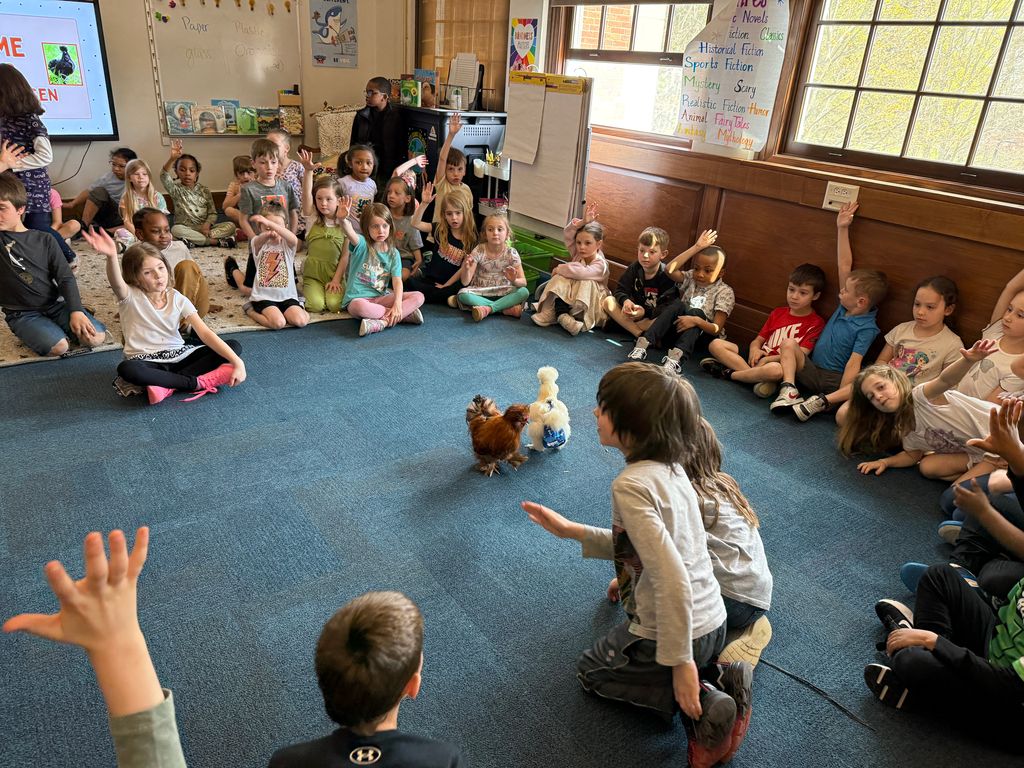
“I brought in one hen; it was a Barred Plymouth Rock named Hazelm in a chicken diaper, which no one had ever seen before. You didn’t have to sign up, it was the kind of thing where people just dropped in to listen to the speakers. A really sizable audience attended.”
From there, she took a four-year hiatus from touring with her chickens but still maintained the coop in her backyard.
After relocating to Rush, Boysen Sluberski was asked to restart the program.
“Our next-door neighbor here in Rush is the director of the Rush Public Library. She said ‘I see you with your Silkie little chickens all the time. Do you think it might be fun to do a chicken storytime and bring a few of your chickens for the kids to pet?’
“I had never done that before; I had only done presentations about teaching people how to maintain coops, but I thought why not? I brought three little Silkie hens that had three little diapers that fit them. I began to realize that a lot of people, even children who live in rural farm towns, have never held chickens before.”
In addition to the children’s storytimes, Boysen Sluberski also gives seminars to adults on how to maintain chicken coops.
“I put together the information from that town’s code. Some towns like Rush are a “Right to Farm Community,’ and there are no restriction whatsoever. However, certain towns such as Honeoye Falls and Brighton say you can keep up to two or three hens, but you can’t have rooster, or you can only have so many; some don’t allow any at all.”
In these seminars, she also gives people tips and suggestions about what types of products are best for keeping chickens in the type of area they are in.
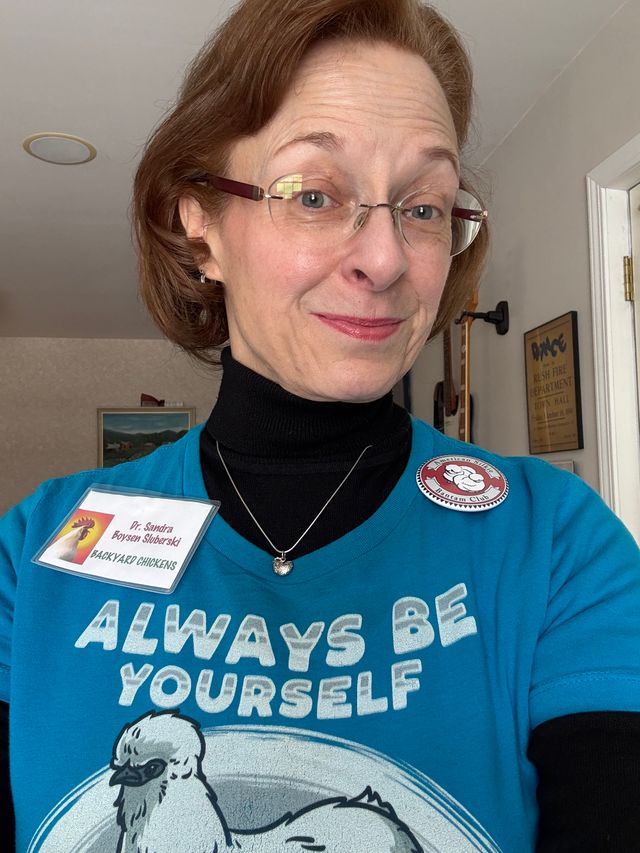
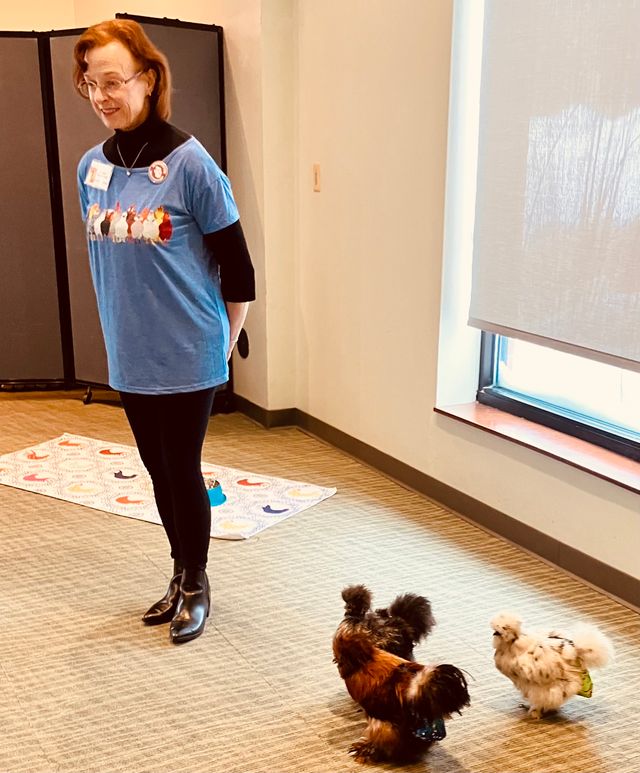
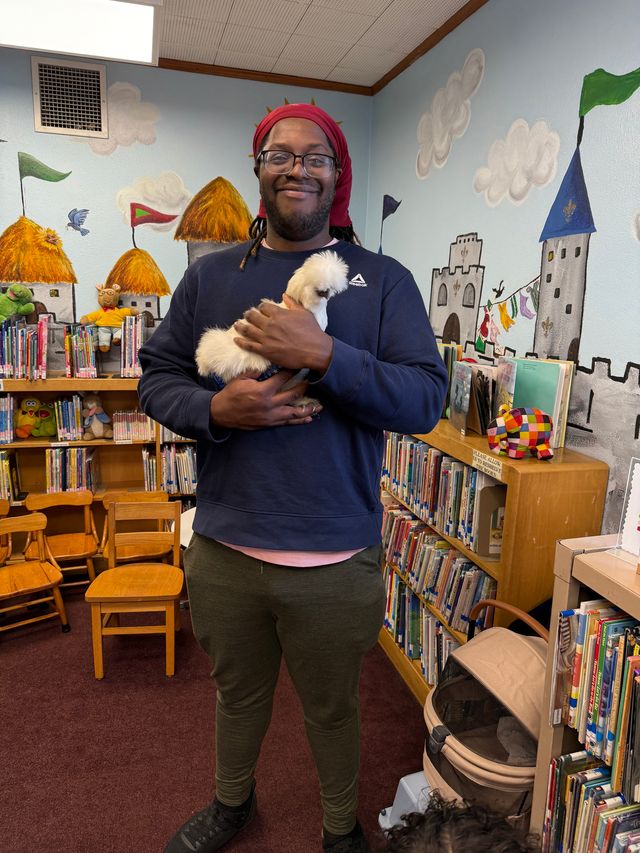
“Because I have a moderately small yard, I use an Eglu, which is a modular plastic home. They’re rounded, about three by six feet and have a curved top wire that keeps out other creatures like dogs or hawks.
“They’re easy to clean because they’re plastic, and they are meant to be taken apart and scrubbed or hosed off. Also, because they are plastic, they don’t harbor poultry mites.”
Boysen Sluberski also gives people specific guidelines to help them raise chickens.
“In the Eglu, to clean the droppings tray I just pull it out, hose and scrub it out, and put it right back in. It’s really very easy to do, and the coops aren’t so heavy that they can’t be moved. This is really important. Ideally you want to move the Eglu around every few days so the chickens have fresh grass to nibble on, just like sheep, horses, and goats.”
Boysen Sluberski is a jack-of-all-trades. Originally from South Florida, she started her career as a music and voice teacher and spent twenty-five years working at the Hochstein School in Rochester. After a long teaching career, she took a step back to focus on her work as a yoga instructor and educating people on chicken keeping.
“I’ve been teaching yoga in Honeoye Falls, leading online and in-person classes, and have been creating content for an online yoga studio, so I have been very busy in my retirement from teaching.”
For Boysen Sluberski, keeping chickens is more than just a backyard hobby; it’s a way to spark joy, connect with her community, and inform the public. Whether she’s collecting their eggs from the coop, reading stories to children, or loading her educational materials for her next adventure, Boysen Sluberski proves that even the smallest and simplest creatures can bring a little magic wherever they go.
Lucy Crounse is a journalism and broadcasting major at SUNY Brockport.
This article originally appeared in the July/August 2025 issue of Upstate Gardeners’ Journal.
Upstate Gardener's Journal


Life is busy, and one great way to simplify mealtime is to prep the day before. Overnight oats have been on-trend for a while now, and for good reason. One small mason jar is packed with fiber, protein, and nutrients. Berries are abundant this time of year, so feel free to swap the blueberries out for strawberries or pitted cherries.
INGREDIENTS:
1/2 cup of rolled oats
1/2 cup milk of choice (dairy, almond, oat, etc.)
1/2 cup Greek yogurt
1/2 cup fresh or frozen blueberries
OPTIONAL ADD-INS:
Scoop of protein powder (add another tablespoon of milk)
A dollop of peanut butter or other nut butter
Mini chocolate chips
Teaspoon of seeds: chia, flax (ground), or sunflower
Chopped nuts
INSTRUCTIONS
Fill a small to medium mason jar with the oats, milk, yogurt, and any optional add-ins. Stir well. Add the blueberries (or other berries) to the top of the jar. Seal the jar and place in the fridge overnight or for five to six hours. Eat cold right out the jar. Enjoy!
This article originally appeared in the July/August 2025 issue of Upstate Gardeners’ Journal.
Upstate Gardener's Journal
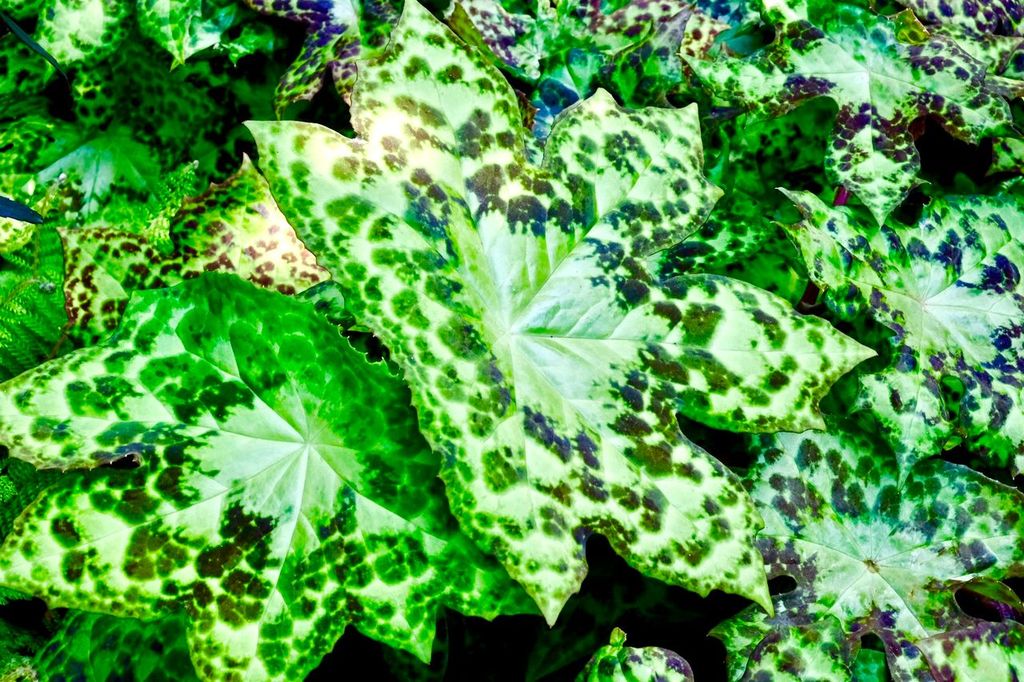

On my travels throughout the years, I’ve noticed an unusual shade plant with large spotted leaves. My first encounter was in Ireland when I visited Lakemount Gardens just north of Cork. It turned up again in the fifteen-acre garden of Janet Blair in New Zealand. One of my savvy travel cohorts reeled off the name ‘Spotty Dotty’, then added “it is a podophyllum. The common name is mayapple!”
On subsequent excursions, I discovered that ‘Spotty Dotty’ thrived in the moist woodlands of Japan, Scotland, and France. OpdeHaar Gardens in the Netherlands, well-known for its woodland and shade-tolerant plants, grows several varieties of podophyllums. On a recent trip to England, I saw a beautiful specimen at Trebah Garden in Cornwall. It popped up again in the Exotic Garden at the Royal Horticultural Society Garden Wisley in Surrey.
PODOPHYLLUM IN CANADA
Just over the border is the Royal Botanical Garden in Burlington, Canada’s largest botanical garden, encompassing over 2,100 acres. For a stunning foliage combination, ‘Spotty Dotty’ is paired up with heuchera ‘Quilter’s Joy’. The sharply lobed leaves of the coral bells look quilted with crisp silver markings on a shiny bronze backdrop, highlighting the mottling on the mayapple.
MAYAPPLES IN THE UNITED STATES
Closer to home, I spotted ‘Spotty Dotty’ growing in the Asian woodland garden at Chanticleer in Wayne, Pennsylvania in both pots and in the ground!
Further south, the Norfolk Botanical Gardens, Virginia’s largest, spanning 175 acres, grows several podophyllum including the mayapple that is native to parts of Western New York, two species of the Chinese mayapple, the spotted mayapple, and the Himalayan mayapple.
On the east coast, Wave Hill in the Bronx has the perfect growing conditions for mayapples. “YES, we grow podophyllum ‘Spotty Dotty’! And we love her. She puts on quite the show,” says Jess Bray, senior horticultural interpreter. “The Berberidaceae are an underappreciated family of plants and ‘Spotty Dotty’ is an outstanding cultivar. We also grow P. peltatum, the native mayapple, in our woods and shade border.”
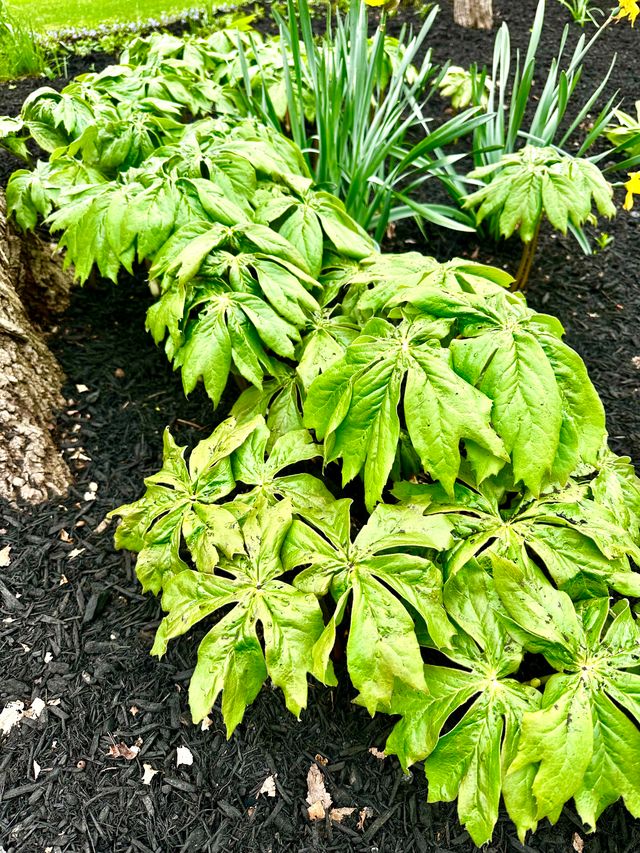
NATIVE VS. COSMOPOLITAN.
So why not pair up the native mayapple with the cosmopolitan ‘Spotty Dotty’ in your garden? The term “cosmopolitan” is used to describe a plant species with widespread distributions, thus grown in many regions or continents around the globe. The Antarctic and Arctic are the exceptions, where temperatures are too extreme. The plants can be native or non-native. Most species are known to be highly conformable with a gamut of environmental and climatic conditions.
Carl Linnaeus first described the genus Podophyllum in 1753 and, according to Plants of the World Online, there are about seventeen species worldwide. P. peltatum is a native that grows from southeast Canada to the central and eastern United States including most of Western New York. It is hardy in zones 6 to 9 and grows in dense colonies in moist soils in part to full shade. White, yellow, or red blooms appear in April and May and attract pollinators such as bumblebees and other long-tongued bees. The blooms mature into a green, yellow or red fleshy fruit later in the summer, thus the common name mayapple. They are a larval host for the golden borer moth and the mayapple borer. Plants spread slowly by rhizomes and can be propagated by root division in the fall while the plant is dormant. Seed-grown plants take several years to mature. Although the native mayapple goes dormant by mid-summer, it makes a stunning statement in the spring garden.
‘Spotty Dotty’, a vigorous hybrid of P. delavayi x difforme, is as easy to grow as the familiar American mayapple. It is a rhizomatous perennial with large, mottled, parasol-like foliage. Plants grow 12 to 18 inches tall in part to full shade in organically rich, moist, well-drained soil. In spring, clusters of nodding maroon flowers dangle under the palmately-lobed leaves, then morph into round, fleshy fruit by late summer. Plants are propagated asexually by tissue culture. Fortunately, deer and rabbits dislike ‘Spotty Dotty’.
ADD TO YOUR SHADE GARDEN
Locally, you can visit Sarah’s Garden and Nursery in Brockport to purchase P. peltatum. Call first to be sure they have plants available. Online sources include Plants Delight Nursery in Raleigh, North Carolina. It lists nine podophyllum species including ‘Spotty Dotty’ and two cultivars of P. peltatum, ‘Maid Marion’ and ‘Wagon Wheels’. At Far Reaches Farm in Port Townsend, Washington, several species are listed on the website as well.
So what will you add to your garden this year —a trusty native or a dramatic cosmopolitan? How about both?
Colleen O’Neill Nice is a horticulturalist who is passionate about plant propagation and enjoys nurturing her garden in Clarence, New York.
This article originally appeared in the July/August 2025 issue of Upstate Gardeners’ Journal.
Upstate Gardener's Journal
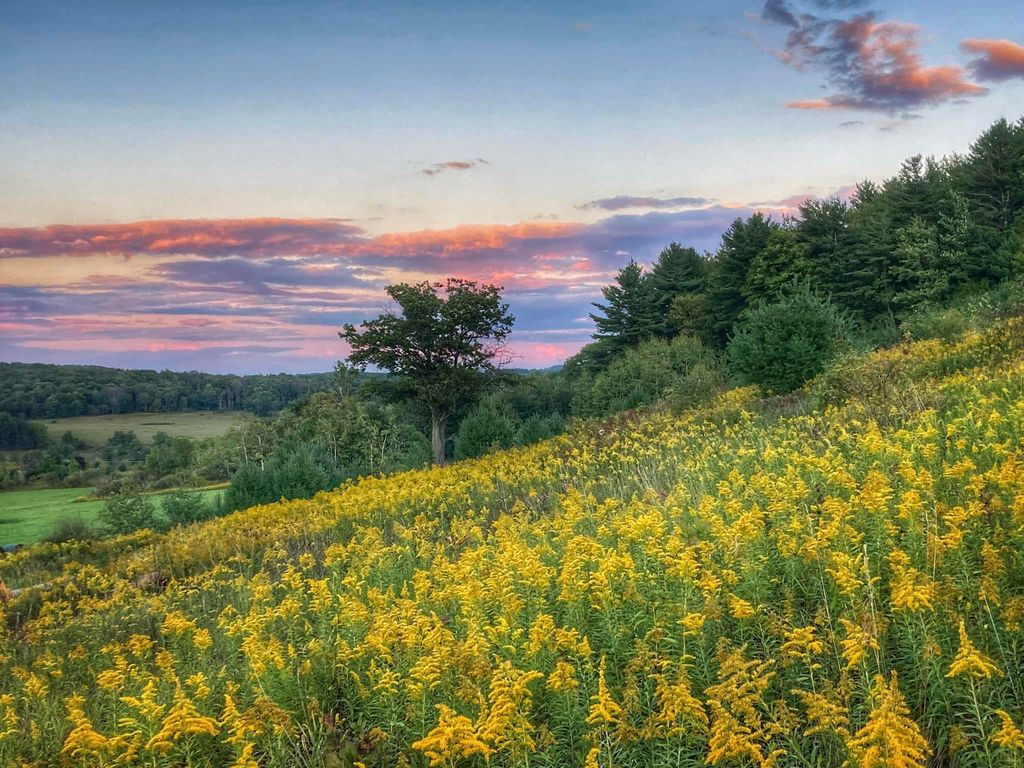

The foliage is growing old;
All through the verdure gleams the gold;
The rose is turning into mold;
But golden rod stands ev’rywhere.
Excerpt from “The Golden Rod” by Samuel Alfred Beadle
When the summer heat begins to give way to cool nights, waves of goldenrod (Solidago spp.) blooms erupt in fields, meadows, roadsides, and gardens that tend towards the wild and free. Nodding gracefully while all at once appearing as a firework, goldenrod is the star of the late summer native flower parade. Small yellow-gold flowers grow in panicles along strong central spikes above narrow foliage. Some species hold these flowers in a central spike, like the narrow or coastal goldenrod (Solidago spathulata), while the showier species, such as Canada goldenrod (Solidago canadensis) are made up of several arching sprays along a tall, central stem.
Goldenrod is easily grown in full sun to part shade, tolerating various soil and moisture conditions, with little to no serious pest issues. There are more than 130 Solidago species throughout the world, and approximately seventy-five known to be native in North America. Two dozen goldenrod species are native to the state of New York. This herbaceous perennial is a late-season pollinator favorite, providing nectar and pollen to the migrating Monarchs and many native bees and insects after the first frosts severely limit foraging options.
The goldenrod genus is rich not only in color, form, and extensive world population, but also in history and culture. The botanical name of the genus, Solidago, is derived from two Latin words, solida, which means “whole,” and ago, “to make,” referring to the many ways several species have been used for healing by different cultures, dating back to the ancient Greeks. Native American tribes used goldenrod as a poultice to treat external wounds and sores for humans as well as horses. Infusions were also made for a wide range of internal ailments, including fevers, pain, and as a sedative.*
In many cultures, goldenrod flowers are a symbol of abundance and wealth. They are often associated with prosperity and are believed to bring good fortune to those who possess them. In ancient Greece, for example, goldenrod was dedicated to the Greek god of wealth, Plutus, and was believed to attract financial success. In some Native American traditions, goldenrod is a symbol of protection and healing, believed to ward off negative energy and bring positive vibes where it grew. The Navajo used it as a good luck charm for gambling, and other tribes used its flowers in ceremonies. A few legends associated with goldenrod are the belief is that if goldenrod grows near a house, its occupants will have good fortune. Another legend states that wherever goldenrod grows there can be found buried treasure.
In Victorian England flowers were given as gifts, and often a message was conveyed by the meaning associated with the flowers in the bouquet. Goldenrod flowers conveyed encouragement and support, often given as a gift to uplift spirits and provide comfort during challenging times. The vibrant yellow flowers were seen as a representation of optimism and hope.
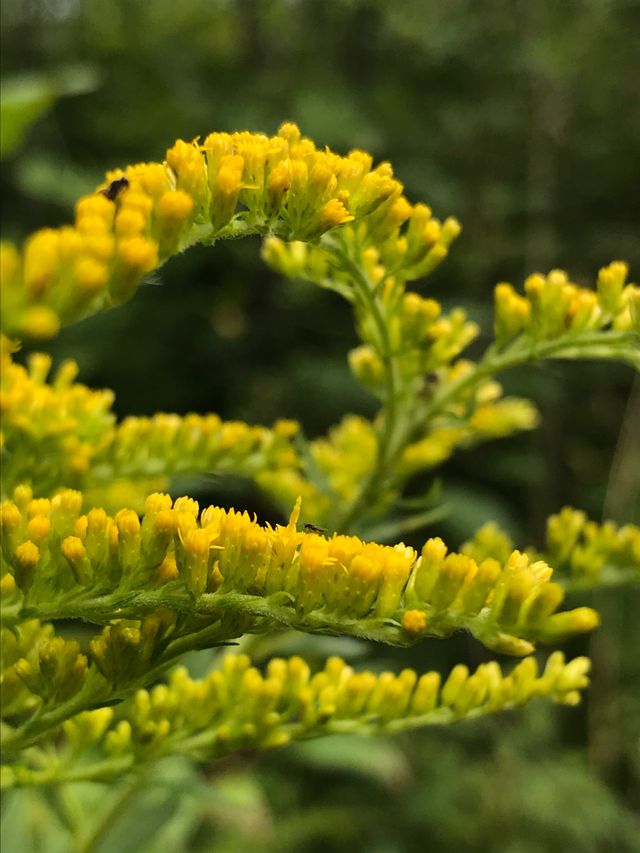
While possibly not covered in your fourth-grade civics class, goldenrod is significantly woven into United States history. After the Boston Tea Party, the infamous dumping of imported tea into Boston Harbor to protest British taxation, the colonists had to find native alternatives for their favorite hot beverage, and goldenrod leaves were the first plant to be brewed as a substitute. Goldenrod tea became known as “Liberty Tea” and for a time it was the exclusive choice for tea leaves in the U.S. colonies.
In the early twentieth century, goldenrod was a frontrunner for the U.S. national flower. Among its competition were columbine, clover, and daisy. Unfortunately, its wrongful reputation as the cause of hay fever may have prevented it from receiving such an honor. The national flower debate continued into the 1980s, long after its inconspicuous growing companion ragweed (Ambrosia spp.) was discovered to be the true hay fever–causing culprit. While goldenrod may have lost out to the rose for the title of National Flower, in 1926 it became the state flower of Kentucky. Solidago gigantea, commonly called giant or early goldenrod, both graces the Kentucky state flag and encircles the state seal.
You’ve heard of Goodyear tires—but how about goldenrod tires? Inventor Thomas Edison experimented with goldenrod’s natural rubber properties. Edison began his search for native plants to source for rubber in the 1920s, with the possible threat of imports from Southeast Asia and the East Indies being cut off. He experimented with a variety of plants at his Fort Myers, Florida, and West Orange, New Jersey, laboratories, and goldenrod proved most promising. He was able to cultivate a twelve-foot-tall plant that yielded as much as twelve percent rubber content. Henry Ford gave Edison a Model T with tires made from goldenrod, but, unfortunately, Thomas Edison died before his project went into commercial production. During World War II there was extensive process development conducted on goldenrod to commercialize it as a source of rubber. However, none were as successful as Edison’s, as they could only cultivate leaves with a rubber content of seven percent. The rubber had a low molecular weight, resulting in an excessively tacky compound with poor abilities to be stretched.
That is quite a lot of history, but let’s not forget the tactile and artsy of us out there. If you are looking for an easy art project, look no further than gathering some goldenrod inflorescence and a piece of fabric that needs enlivening. The yellow-gold flowers can easily be used as a dye on their own for a sunshiny hue or combined with the blue flowers of Baptisia (False Indigo) to create shades of green. So the next time you take a late summer stroll and see the golden waves in all their glory, enjoy them for what they are, a bright, robust native pollinator plant, and think on all they have been and could be. Liberty tea and afternoon tie-dyeing anyone?
Bonnie Warriner is a horticulturist and budding flower farmer with a love for capturing beauty in pictures and words. You can find her among the wildflowers and goats on her family’s 150-acre farm in Jasper, New York.
Want to try dying fabric with goldenrod? See our September/October 2022 issue for directions. The full issue is available at upstategardenersjournal.com.
This article originally appeared in the July/August 2025 issue of Upstate Gardeners’ Journal.
Upstate Gardener's Journal
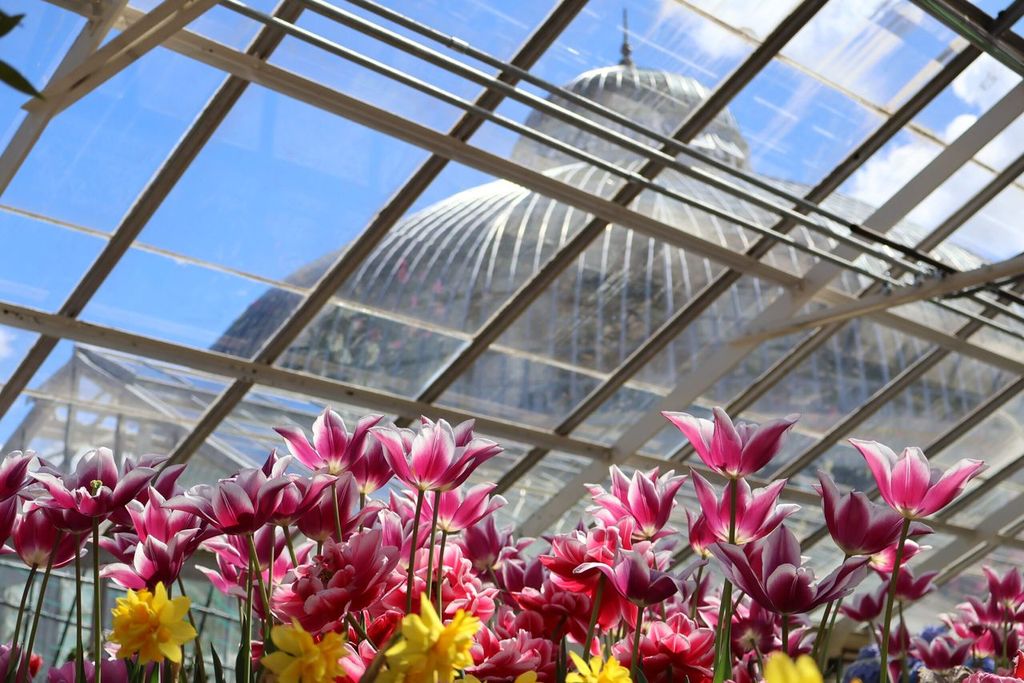

SAP TAP FARMS INTRODUCES SUSTAINABLE WOOL PELLETS
Sap Tap Farms is partnering with local sheep farmers to produce a natural, slow-release fertilizer alternative made from wool pellets. The small family-owned farm in Bloomfield uses raw sheep fleece that would otherwise be wasted to make wool pellets that can hold about twenty times their weight in water. These pellets are useful for regulating soil water retention and reducing watering for plants.
The farm, in conjunction with local sheep farmers, is also partnering with Operation Walk New York, a nonprofit that provides free hip and knee replacements to underserved patients. OpWalk NY specializes in helping those who suffer from joint pain or arthritis. It provides medical personnel, equipment, and supplies for each of its mission trips and builds its own operating rooms to provide medical assistance to those in need. Some local sheep farmers have chosen to donate their payments from the wool pellets to support OpWalk NY and their next mission in Ghana, funding life-changing surgeries.
Sap Tap Farms owners Chris Graffeo and Jenn Voorhees say, “We work directly with local farmers helping to provide them extra cash for their waste wool. It is our strong belief that wool has value. When we first started our sheep journey, Jenn was bothered by the amount of waste that we encountered and being told that wool had little to no value to farmers. It seemed more like a burden than anything else to them. Jenn started researching alternatives and there was an answer we could work toward: ‘wool pellets.’”
The wool pellets work in both wet and dry conditions and allow for strong root growth. The pellets are perfect for hanging baskets and containers on decks because of their water retention capabilities. Normally hanging baskets can be extremely dry during the summer, but these pellets will slowly release water to maintain healthy soil. Upstate Gardeners’ Journal’s editorial team is using the wool pellets in their personal gardens to test out the pellets’ abilities.
Graffeo and Voorhees are passionate about their community and connections with local farmers. They produce syrup, honey, and wool pellets on their farm and will soon be producing meats from their growing flock of sheep. Sap Tap Farms was able to save over 4,000 pounds of wool from local farmers just last year. They are continuing to offer alternatives to better sustain our environment. For more info visit saptapfarms.com.
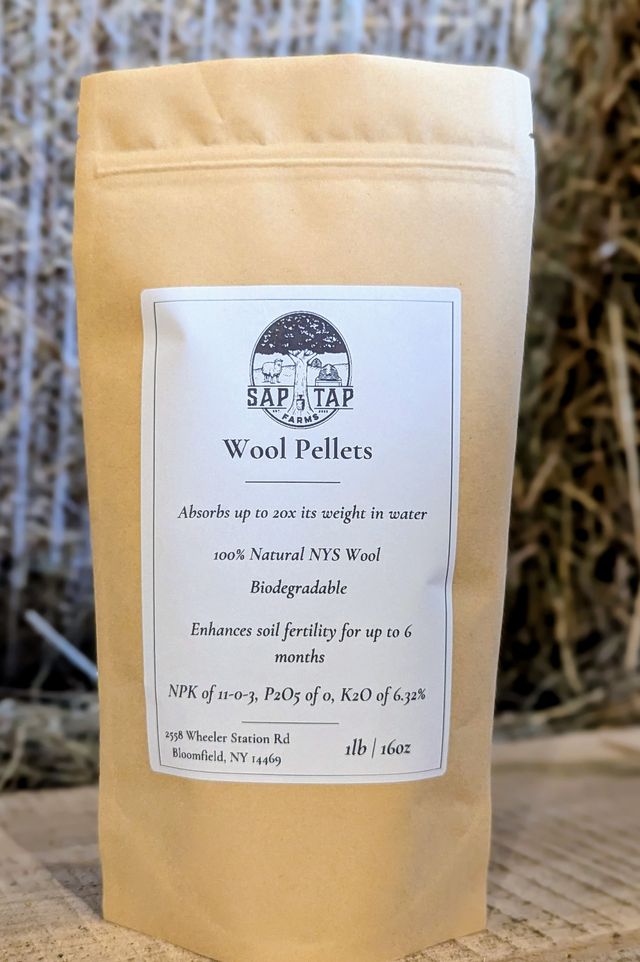
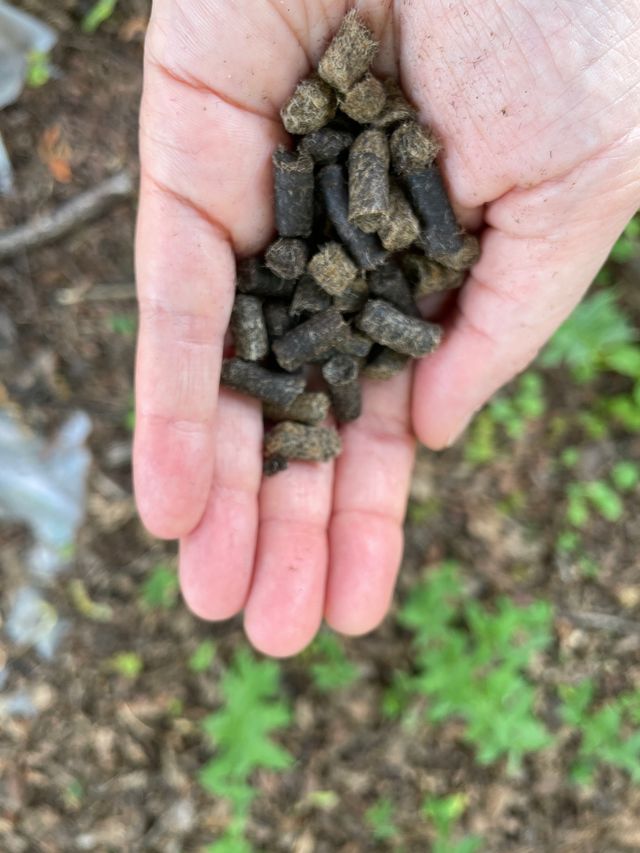
BECBG CELEBRATES 125 YEARS
The historic Buffalo and Erie County Botanical Gardens is observing 125 years of being on operation. Originally called the South Park Conservatory, its doors opened in 1900. Frederick Lord and William Burnham of Lord & Burnham Co. were hired as the designers of the botanical gardens and modeled the tri-domed building after the Crystal Palace in England. It is located within a park system that was designed by Frederick Law Olmsted in the 1800s. Olmsted was also known for designing several renowned parks around New York and the US, including Central Park in New York City and Mount Hope Cemetery in Rochester. Today the land is owned by Erie County and operated by the Buffalo and Erie County Botanical Gardens Society, Inc. Visitors to the gardens will experience an arboretum and rich outdoor gardens across twelve magnificent acres. The gardens are open year-round and host workshops and special events to share the beauty of the conservatory. Admission is $18 for adults, $9.50 for kids 3–12, and botanical gardens members get in free. For more info visit buffalogardens.com/plan-your-visit.
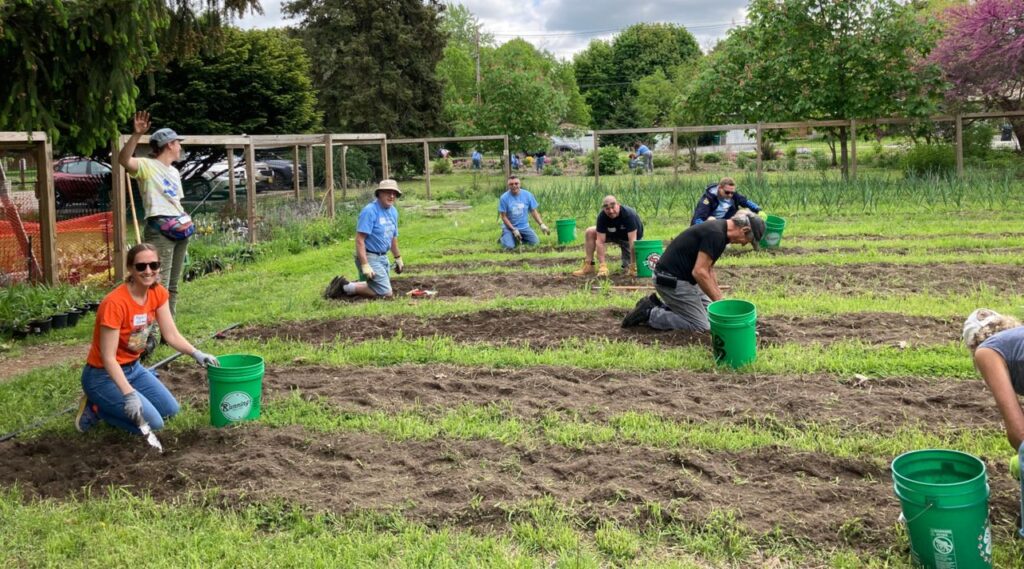
CCE DAY OF CARING A SUCCESS
On May 15, the Cornell Cooperative Extension of Monroe County (CCE Monroe) participated in the 2025 Day of Caring. This is an annual event that gives local businesses and members of the community an opportunity to give back, hands-on. This project builds community and uplifts local businesses, schools, and community organizations in the Finger Lakes Region. CCE Monroe had more than forty volunteers from CareStream and Quidelortho join the project to accomplish weeks’ worth of tasks in just one day. These volunteers took on landscaping work from weeding to setting up the biochar (a sustainable soil enrichment tool) kiln. Volunteers primarily worked on the South Lawn Farm, preparing planting beds and helping maintain the land.
CCE Monroe provides educational opportunities and outreach projects, like the Day of Caring, to ensure that communities in Monroe County thrive. “We are incredibly grateful for the outpouring of support and service shown by each and every volunteer,” says Andrea Lista, executive director of CCE Monroe. “It was inspiring to witness such commitment to strengthening our shared community spaces.”
Abby Chamot is a senior journalism major at James Madison University in Virginia.
This article originally appeared in the July/August 2025 issue of Upstate Gardeners’ Journal.
Upstate Gardener's Journal
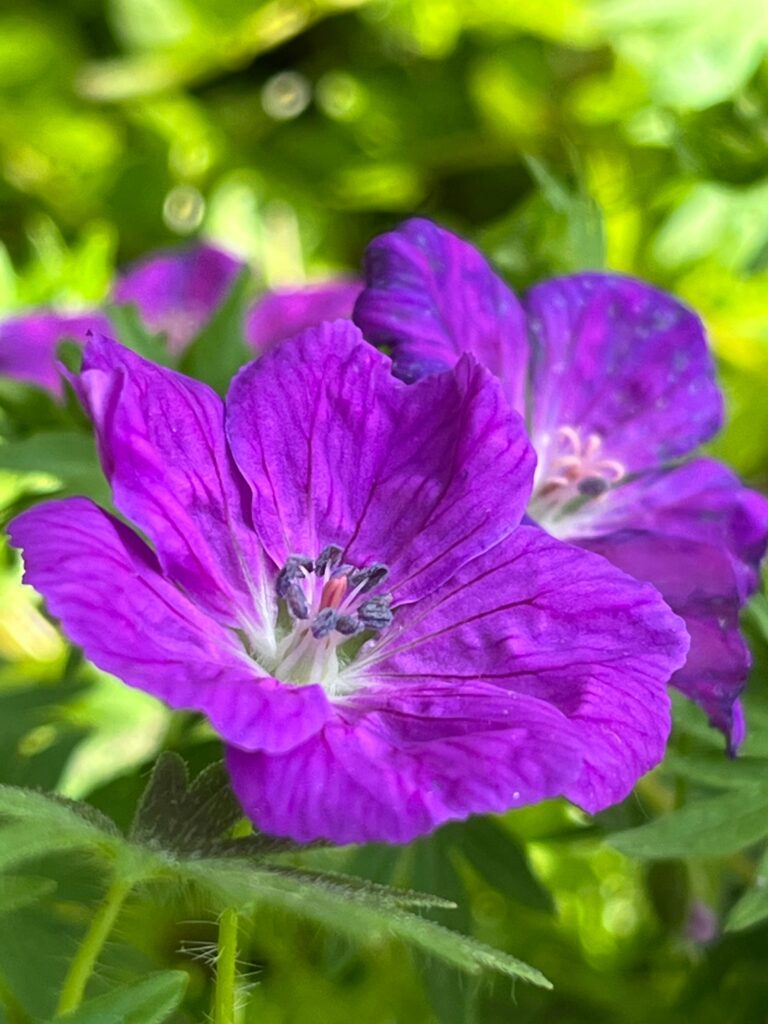
BUFFALO REGULAR CLUB MEETINGS African Violet & Gesneriad Society of WNY meets the third Tuesday of the month, September–August, at 7 p.m., Greenfield Health & Rehab

Flower frogs are a helpful tool to assist with arranging flowers because they keep the stems in place. They date back to fourteenth century Japan,

Hummingbirds are incredible little birds with amazing adaptations. During flight they beat their wings anywhere between seventy and 200 times per second, which gives off

In Dr. Sandra Boysen Sluberski’s backyard, the cluck of chickens mixes with the hum of daily life, a rhythm that reflects her own harmony between

Life is busy, and one great way to simplify mealtime is to prep the day before. Overnight oats have been on-trend for a while now,

On my travels throughout the years, I’ve noticed an unusual shade plant with large spotted leaves. My first encounter was in Ireland when I visited

The foliage is growing old; All through the verdure gleams the gold; The rose is turning into mold; But golden rod stands ev’rywhere. Excerpt from

SAP TAP FARMS INTRODUCES SUSTAINABLE WOOL PELLETS Sap Tap Farms is partnering with local sheep farmers to produce a natural, slow-release fertilizer alternative made from
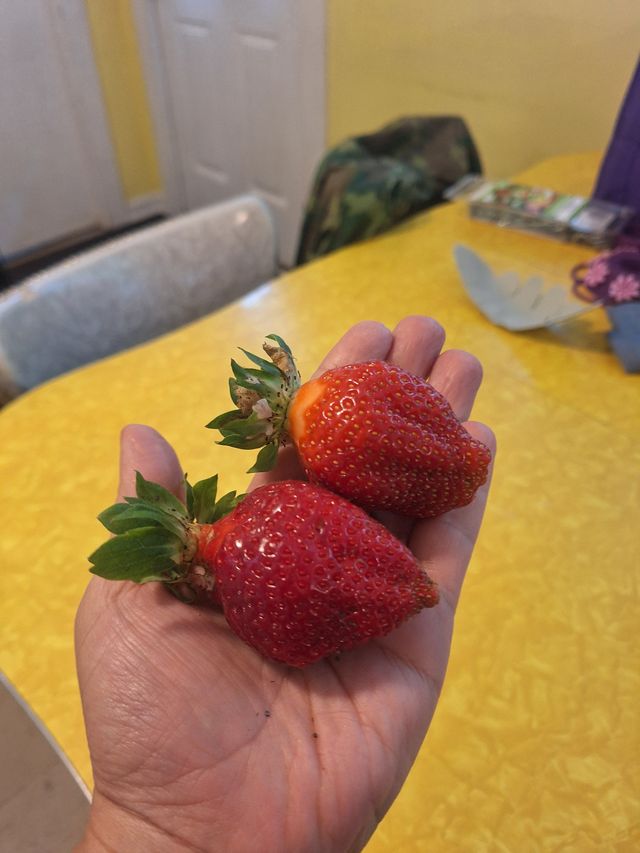
If you’re like me, you are knee-deep in weeds. It seems like one day we’re anxiously watching little sprouts emerge in May and June then

Ahhh summer … Picnics, graduation parties, weddings, backyard gatherings with neighbors. Children at home. ALL. DAY .LONG. I am certain that my children don’t eat
